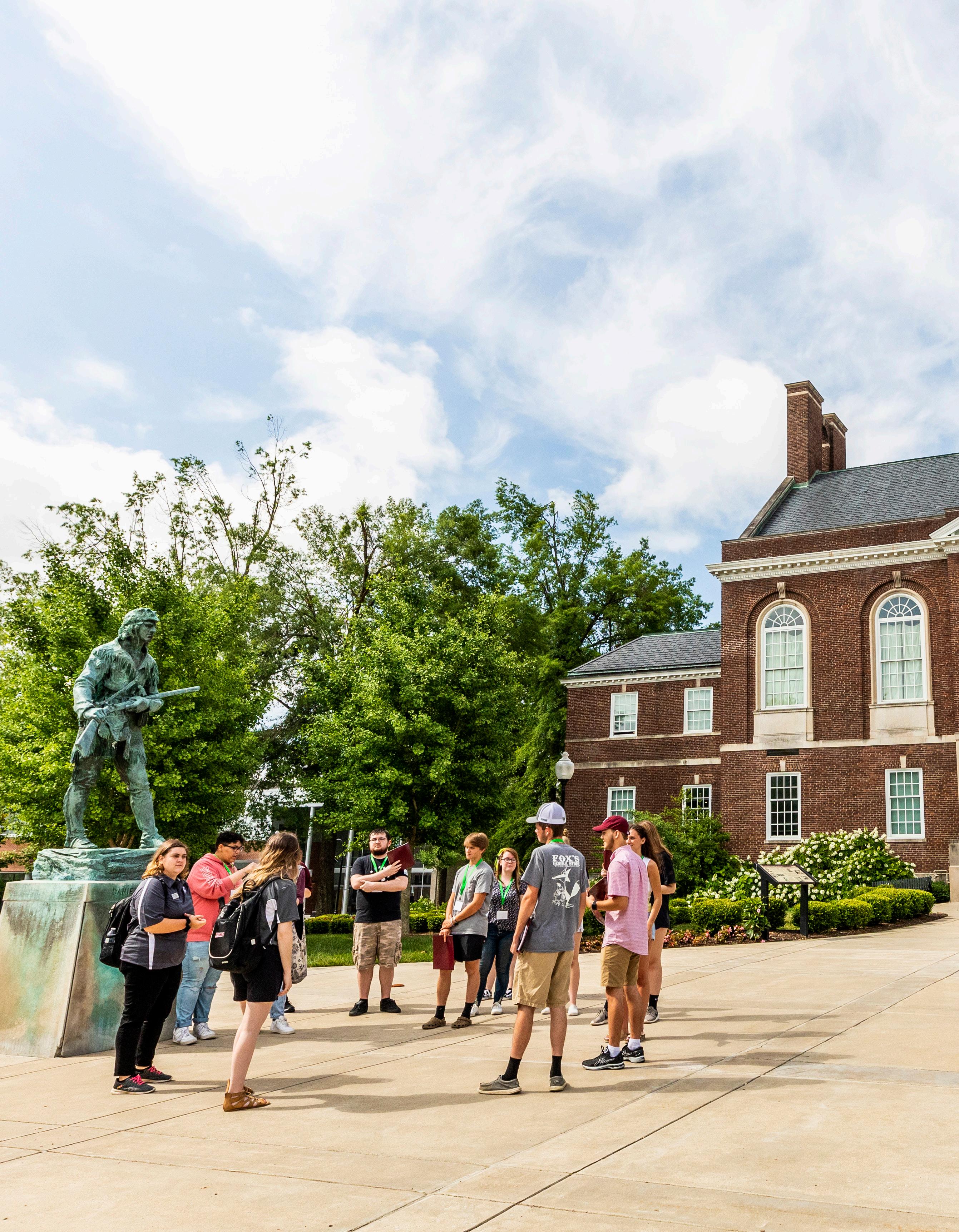







Eastern Kentucky University is the School of Opportunity. Each year, thousands of faculty, students, families, alumni, and guests from across our state and region converge on the Campus Beautiful eager to live, learn, or engage with our institution. From nursing and aviation to education and supply chain management, EKU attracts students seeking transformational experiences. Our commitment to excellence in education brings faculty and staff from around the world with a goal of preparing our students to be change agents in the workforce of tomorrow.
Universities shape communities beyond the classroom. The financial impact of EKU on the Commonwealth, both statewide and locally, is substantial. Since 1906, EKU’s presence has significantly enhanced the economic vitality of the City of Richmond, City of Berea, Madison County, as well as central and eastern Kentucky. Whether it be faculty and staff relocating to live and raise their families or students who come for an education and choose to stay, EKU adds tremendous value to this region.
Thanks to the work of the Center for Economic Development, Entrepreneurship & Technology; the Division for Regional Economic Assessment and Modeling; and Student Success, Engagement and Opportunity, the economic impact of Eastern Kentucky University has been measured extensively. Our researchers estimate EKU generates $580.63 million dollars in university, student, and visitor expenditures each year, supporting more than 6,600 jobs and $247.01 million in labor income in Madison County and the surrounding region.
In addition, EKU’s presence is a magnet for leading businesses and talent in a highly competitive workforce. Through our community outreach with local businesses, commitment to higher education for our adult learners, and our town-and-gown relationships, EKU is proud to shape the economic vitality of communities that we serve.

 One Eastern, Dr. David T. McFaddin President, Eastern Kentucky University
One Eastern, Dr. David T. McFaddin President, Eastern Kentucky University
Evidence supporting this figure includes:
1
EKU expenditures support $421.54 million in economic activity, supporting 5,244 jobs and $206.24 million in wages in the region.
Although not included as part of the economic impact estimate, the researchers also find that:
Students attending EKU spend an estimated $148.47 million in Madison County, Madison’s surrounding counties, and EKU’s extended campus counties each year. This supports an estimated 1,226 jobs and $36.58 million in wages in the region.
EKU events attract an estimated 343,203 people to Madison County each year, supporting $8.19 million in expenditures, 107 jobs, and $2.94 million in local wages.
Visitors to EKU NCAA sporting events held at the main campus in Richmond support $2.42 million in expenditures, 46 jobs, and $1.24 million in local wages.
3 4 2 5 A B
EKU’s presence in Madison County supports nearly 6,000 jobs and $225.01 million dollars in local wages exclusively in Madison County.
EKU generated $113.87 million in building construction and $17.63 million in repairs and maintenance projects since 2017. This has supported over 1,670 short-term construction jobs and $77.70 million in local wages.
EKU postgraduates represent $175.22 million in wages inside EKU’s service region with 76% of EKU graduates finding full-time jobs within six months of graduation. When considering Appalachian Regional Commission counties in Eastern Kentucky, EKU postgraduate salaries increase to $199.35 million.
EKU employees annually generate over $2 million dollars in resident and occupational taxes and another $1.70 million in property taxes in the surrounding region.
Meet the Researchers
Methods Summary
Section One: University Expenditures

Section Two: Student Expenditures
Section Three: Visitor Expenditures at EKU Events
Section Four: Visitor Expenditures at EKU NCAA Sporting Events
Supplemental Section A: EKU Construction Expenditures
Supplemental Section B: EKU Student Post-graduation Salaries in the EKU Service Region
Supplemental Section C: Residential and Occupational Taxes Generated by Eastern Kentucky University Employees
Supplemental Section D: Potential Negative Economic Impacts from Changes in EKU Employment or Student Enrollment
Study Limitations

Dr. James Maples is an Associate Professor of Sociology and Director of EKU’s Division for Regional Economic Assessment and Modeling (DREAM) at Eastern Kentucky University. His research agenda examines rural economies in transition with a focus on utilizing outdoor recreation as a sustainable base of economic growth.

Kobe Perry is a sophomore Biology and Biomedical Sciences major at Eastern Kentucky University. As an aspiring physician, his research interests primarily include medicine, epidemiology, and public health policy.

Dr. James Blair is an Assistant Professor of Marketing at Eastern Kentucky University. He is currently a Fellow for the Direct Selling Education Foundation and also serves on the Editorial Review Board for the Journal of Consumer Marketing. His research examines consumer behavior. More specifically he researches participative pricing, sales, sport marketing, and marketing pedagogy.

This study utilizes IMPLAN to analyze the economic impact of the university. IMPLAN stands for IMpacts for PLANning and is a leading input-output economic impact analysis toolkit. IMPLAN was created as a result of the 1976 National Forest Management Act and United States Forest Service (USFS) management planning. IMPLAN (then called FORPLAN for FORest PLANning) was first used by the USFS in 1978. IMPLAN would later be relocated to the University of Minnesota in 1985 to provide greater support for developing IMPLAN’s datasets. Soon, IMPLAN became an independent corporation, adapting the datasets and software into today’s leading input-output economic impact estimator.
IMPLAN operates on the premise of input-output modeling. This approach demonstrates how different parts of the economy are linked in that spending in one sector of the economy (such as general retail purchases) impacts another sector (e.g, transportation or warehousing). IMPLAN software utilizes US Bureau of Labor Statistics data to create a modeling sandbox of a specific area’s economic activities. Researchers can then add in specific activities (such as regional basketball tournament) to understand what occurs in the economy as a result of that activity. These impacts are quantified most commonly as job creation and wage creation. This is discussed later in this section.
This study is built in part upon university expenditures, event attendance, and
student enrollment data from the 20182019 academic year. This year was selected because it was the most recent year not impacted by the pandemic. Additionally, 2018-2019 represents a typical and representative year for studying the university’s expenditures. As such, the study examines expenditures and events which occurred that academic year. As it is not feasible to go back in time to collect student expenditures data from 2018-2019, the study uses student expenditures data from a 2021 survey to model what 20182019 student expenditures would have looked like.
Economic impact studies are designed around a study area which includes the activity being studied and the expenditures created by that activity. For this study, Madison County is used as the main study area and is included in all areas of this report. In select expenditure studies (such as student, event visitor, and sport visitor) a portion of expenditures are also modeled in the counties surrounding Madison. These include Fayette, Clark, Estill, Jackson, Rockcastle, Garrard, and Jessamine counties. In studies involving extended campuses (such as the university and student expenditures portions of the study), Whitley, Knox, Garrard, Clay, Perry, Pulaski, and Boyle counties are also included. In the EKU events study, the researchers also use a study area comprised of Letcher, Garrard, Whitley, Knox, and Pulaski counties to examine events in those areas. The study areas used in each study is discussed at the start of each sub-section of this report.
University economic impact studies are built around specific areas: operational budgets (expenditures that ensure the university operates including wages), capital expenditures (construction and maintenance costs), student living expenditures (such as groceries and gasoline), and campus events (which includes sporting and conferences). An economic impact study would be able to explore how these spending events create other expenditures in the area surrounding the university. This study examines each of these areas, delineating events into NCAA sporting events and all other events for additional nuance.
There are additional areas mistakenly examined in other university economic impact studies that are correctly excluded here. The first is the inclusion of employee expenditures in the study area. This would include things like mortgages, groceries, and retail purchases. When using IMPLAN, these expenditures are already included in the analysis through the study of indirect and induced impacts (which are defined later in this report). As such, to include them again as a standalone category would artificially (and incorrectly) inflate economic impact estimates. A second common issue is including expenditures twice, such as scholarships and student expenditures. Students receive scholarships and these can cover living expenses such as food or lodging. However, modeling the expenditure AND the scholarships creates a high risk of double counting and therefore inflating economic impact estimates. A third common issue is including construction expenditures as long-term jobs. Construction jobs are, by
design, temporary. As such, these jobs are included as a separate supplement to the study. While the construction costs for 2018-2019 are noted in the university expenditures section of the study, the expenditures are not modeled. Throughout, the researchers adhere to best practices in modeling expenditures and also consulted with IMPLAN representatives to verify correct steps have been taken to provide a conservative estimate of EKU’s impact on the region.
There are multiple data sources in this study. For simplicity and clarity, each is discussed in its appropriate section of the report alongside tables summarizing the data.
In this study, researchers use three terms to describe economic impact: direct effect, indirect effect, and induced effect. Putting these terms into an example, the authors will use these terms by thinking about what happens when a student buys a pizza from a restaurant near campus.
First, pretend this student goes to a nearby restaurant to buy some pizza on a Friday night. For our example, pretend the student pays $10 for this pizza, tax included. This expenditure represents the first round of spending, what is called the direct effect The direct effect is the economic activity created by the money spent as a result of the activity being studied. The student in this example has now injected ten new dollars into the study area. Additionally, those ten dollars would not be part of this economy if the student were a student at another university.
Next, that $10 spent begins to work through the economy. This direct effect can now generate further change in the local economy via indirect and induced effects. Indirect effect is economic activity created when local businesses purchase goods and services from other local industries as a result of the direct effect. In the present example, the owner of the pizza restaurant needs to buy more supplies to make more pizzas, as well as pay electric and gas bills and pay workers. These are all indirect effects of that $10 spent by our example student.

Some of the indirect effects include wages paid to workers and these wages will again be spent in the local economy. This is the induced effect: the estimated expenditures by local households and employees. For example, a pizza restaurant employee may choose to spend their wages at another local business, creating additional rounds of local economic activity. These expenditures are linked back to the initial $10 spent on pizza. This process continues until the funds leak out of the study area.
This study further considers how expenditures generate different kinds of economic impact in the region. These include job creation, labor income, value added, and output. Jobs creation operates on the premise that a portion of an employee’s job is dedicated to engaging to the activity being studied. Returning to our pizza example, a pizza kitchen employee’s job could (for example) spend 15% of their time creating pizzas for EKU
students and staff. IMPLAN estimates jobs creation using this approach and reports an estimate of total job portions supported by the activity being studied. This includes full and part-time works as well as proprietors. Labor income impact is measured by the estimated labor income (for employees and proprietors) created by the economic activity in the region. Labor income impact is a conservative estimate of economic impact and is the approach highlighted in this report. Value added indicates the true economic wealth added to the local economy after subtracting the cost of inputs needed to conduct everyday business. Value added includes expenditures in profit, employment compensation, and taxes. Finally, output is value added plus total revenues and sales from economic activity.
IMPLAN also analyzes taxes created as the result of the expenditures being studied. Taxation levels include the sub-county (general and special district), county, state, and federal tax levels. Note a distinction is made in the analysis between subcounty general and sub-county special district. The former is collected by local government (such as a city or town) while the latter is collected through district taxes (e.g, schools). The following taxes are included at the sub-county, county, and state levels: property, motor vehicle, motor vehicle license, industry severance, special assessments, other taxes on production and imports, personal income, and corporate profits. Federal taxes include social insurance taxes, excise taxes, customs, corporate profit taxes, personal income, and estate/gift taxes.

This portion of the study uses three study areas: Madison County, counties surrounding Madison County, and extended campus counties. Expenditures are modeled only in Madison and in the extended campuses, while the surrounding counties study area is included to capture how expenditures leak from Madison into the surrounding area. This process is discussed later in the report.
WAGES AND BENEFITS TOGETHER REPRESENT $163.79 MILLION ANNUALLY RETURNED INTO THE COMMONWEALTH’S ECONOMY
University Expenditures Data
Data for the university expenditures portion of the study were provided by EKU Accounting and Reporting. The data represent the actual 2018-2019 expenditures, not budgeted expenditures, to provide a clearer understanding of the university’s impact. The expenditures are divided into two categories for analyses: labor income (which includes wages and benefits) and non-labor expenditures (which include purchases, travel, and any other expenditures by the university that are not linked to wages). These categories are later modeled such that expenditures from the Richmond campus are linked to Madison County and expenditures at extended campuses are linked in the extended campus counties study area.
Table 1.1 lists wage and benefit summaries for EKU in the 2018-2019 academic year. Wages totaled $121,161,634.45 in 2018-2019. This includes $40.65 million in faculty wages and $40.32 million in staff wages, as well as $396,081 in extended campus salaries, to name a few of the wage categories. EKU also provided $42.63 million in benefits in 2018-2019. Benefits include items like

insurance and retirement system payments. For example, in the 2018-2019 academic year EKU contributed $39.14 million in employee insurance benefits. The university also added $185,821 to the Kentucky Employee Retirement System. As EKU is dedicated to supporting EKU employees seeking college degrees, EKU supported $2.54 million in employee scholarships that year. Wages and benefits together represent $163.79 million annually returned into the Commonwealth’s economy, supporting families and further expenditures throughout Kentucky.
Non-labor Income Expenditures
Table 1.2 describes non-labor expenditures from EKU’s 2018-2019 budget. Non-labor items are all expenditures not related to worker wages or worker benefits. These often represent physical items being purchased, repairs to existing items, services, and resources needed so the university can operate and serve its students. Expenditures are lumped into sub-categories for simplicity. For example, general and administrative expenditures at the Richmond campus (which totaled $14.48 million) included a wide variety of activities like printing, buying supplies for offices and research, purchasing equipment, and maintaining existing equipment. The largest category in the table is Other Services ($100.59 million) which covers the many services needed to run a university. Scholarships (at $87.05 million) is the next largest category.
Table 1.2 includes $261.73 million in university activities, $257.74 of which are expenditures. Note not all of these expenditures are included in the actual
economic impact analysis for specific reasons. First, scholarships are not included as student expenditures are later modeled separately in this study. Second, capital expenditures are not included as these are examined separately later in the study. Third, cost recoveries are not included
as these are largely through grants from outside the region. This leaves a total of $132.0 million to be analyzed in the study as non-labor expenditures. Although not specifically summarized in the table, a total $518,034 is attributed to extended campuses per expenditures data.
Faculty Salaries $40,658,143.07
Staff Salaries $40,322,577.57
Overload Salaries $1,871,790.79
Salaries, Part-time $2,881,177.29
Classified Wages $21,533,326.20
Overtime Wages $348,865.85 Separation Payouts $33,581.23
Salary Incentives $125,385.25
Salaries Extended Campus $396,081.28
Consultants $4,106,087.28
Summer Salaries $2,635,328.81
Graduate Assistants $2,439,920.08
Institutional Work Study $3,220,294.72
Federal Work Study $589,055.03
Personnel Expense Transfers $20.00
Category Total $121,161,634.45
Category: Benefits
Employee Benefits
$39,141,289.26
Kentucky Employee Retirement $185,821.69
Kentucky Teachers Retirement -$610.59
KTRS - Overmatch Contribution -$438.09
Retirement Sick Leave Svc Credit $180,460.54
Social Security $364.18
Health Insurance $982.43
Dental Insurance -$1.82
Unemployment Compensation $416,404.35
Employee Scholarship $2,548,274.37
Taxable Benefit $161,258.16
Benefits Cost Recovery $1.68
Category Total $42,633,806.16
Table Total $163,795,440.61
Table 1.2: Non-labor Income Expenditures at Eastern Kentucky University (Items marked with * are not included in the analysis) (total: $257,748,226.81)
General and Administrative Expenditures (includes areas like printing, operation supplies, equipment purchase and repair, and lab equipment) $14,485,869.71
Telecommunications and Maintenance (includes things like electricity, water/sewer, tele-communications, and postage) $13,145,552.12
Other Services (includes things like student support services, advertising, facility rentals, and promotional expenses) $100,593,191.31
Scholarships (includes things like Pell Grants and EKU Institutional Scholarships)* $87,053,956.47
Travel Expenditures (includes things like in and out of state travel and athletic team travel) $4,300,842.10
Capital Expenditures (includes things like building maintenance, construction, and purchasing library materials)* $40,163,062.79
Cost Recoveries (includes things like recovering the costs of research in the region)* ($1,994,247.69)
In the analysis, labor income is modeled as a labor income event in IMPLAN. Non-labor income expenditures are categorized as an industry spending pattern (category 481, Junior Colleges, Colleges, Universities, and Professional Schools). Madison expenditures include $163.39 million in labor expenditures and $132.0 million in non-labor expenditures. Extended campuses included $396,081.28 in labor income expenditures and $518,034.92 in non-labor expenditures.
The analysis utilizes a Social Accounting Matrix (SAM) analysis, which allows IMPLAN to decide, based on its knowledge of university industry spending patterns, how expenditures are occurring (if at all) within the study area. This is the appropriate choice as the researchers do not know the origins or locations of the purchases. This analysis also includes Multi-Regional Input-Output (MRIO)
analysis to consider how expenditures in Madison may also leak into surrounding counties as well as the extended campus locations, providing a fuller picture of how EKU expenditures impact the study areas.
In analyzing most any other expenditure pattern, the analysis could be created based on the data discussed thus far. However, as EKU is a public and non-profit institution, additional steps are required when appropriately estimating its economic impact in IMPLAN. First, the direct and indirect levels are added together to make the new indirect estimate. Next, the known job count at EKU (3,994, which includes graduate assistants and student workers) is imputed as the direct job impact and the analyzed labor expenditures are included as the direct labor income impact. Value added (which includes profits and taxes) would be equal to the direct labor income impact as this is a non-profit public institution.
Finally, the output would be equal to the value added plus the non-labor income expenditures.
Table 1.3 summarizes the results of this analysis. The researchers find that EKU supports over 5,200 jobs in the study areas, including over 5,000 full and part-time jobs in Madison County. EKU expenditures also support $206.24 million in wages in the three study areas and $200.13 million specifically in Madison County. EKU also supports modest job activity in the extended campus study area (86 jobs) and $1.01 million in wages. Although not listed in the table, EKU’s expenditures generate activity in the counties surrounding Madison, supporting 104 jobs and $5.10 million in wages.
Table 1.4 explores the taxes generated by EKU’s expenditures. These include breakdowns of taxation at the sub-county (general and special district), county, state,
and federal tax levels. Collectively, EKU expenditures generate $16.99 million dollars in taxes across all levels, including over two million dollars in sub-county and county taxes.
Table 1.5 examines how EKU expenditures impacts the study areas’ job market. At the direct level, EKU supports its own 3,994 employees, which includes full and part-time workers as well as graduate assistant and student workers. However, at the indirect and induced levels, EKU expenditures support jobs in numerous categories. These are most notable in several groupings: operating residential properties, leasing nonresidential buildings, and renting tenant-occupied housing (253 jobs total); dining service which includes sit-down waitstaff meals (full-service), fastfood (limited-service), and bars and taverns (168 jobs total); building maintenance and service (53 jobs total); employment services (18 jobs); and medical care (65 jobs).
Jobs Labor Income Value Added Output
Direct, All Study Areas 3,994.00 $163,795,440.61 $163,795,440.61 $296,320,895.85
Indirect, All Study Areas 590.49 $18,867,794.22 $35,210,566.65 $90,013,340.83
Induced, All Study Areas 659.52 $23,584,511.25 $46,675,369.51 $83,455,144.34
Total, All Study Areas 5,244.01 $206,247,746.08 $245,681,376.77 $469,789,381.02
Direct, Madison Only 3,923.00 $163,399,359.33 $163,399,359.33 $295,406,779.65
Indirect, Madison Only 549.75 $16,893,120.47 $31,673,122.71 $81,997,931.94
Induced, Madison Only 580.01 $19,838,789.69 $40,363,634.16 $71,445,584.51
Total, Madison Only 5,052.76 $200,131,269.49 $235,436,116.20 $448,850,296.10
Direct, Extended Only 71.00 $396,081.28 $396,081.28 $914,116.20
Indirect, Extended Only 6.16 $238,049.31 $450,183.40 $1,119,071.23
Induced, Extended Only 9.21 $379,961.75 $665,794.81 $1,331,452.14
Total, Extended Only 86.37 $1,014,092.34 $1,512,059.49 $3,364,639.57
Sub-County (General) Sub-County (Special Districts) County Taxes State Taxes Federal Taxes Total Taxes
Direct NA NA NA NA NA NA
Indirect $334,073.52 $475,199.04 $61,880.89 $2,031,840.47 $3,704,419.57 $6,607,413.49 Induced $557,753.99 $1,015,588.33 $107,706.33 $3,926,158.02 $4,779,432.55 $10,386,639.22
Total $891,827.50 $1,490,787.36 $169,587.22 $5,957,998.49 $8,483,852.11 $16,994,052.71
Industry Display Direct Indirect Induced Total 481 - Junior colleges, colleges, universities, and professional schools 3,994 39.47 8.67 4,042.14 447 - Other real estate 0 219.37 16.97 236.34 509 - Full-service restaurants 0 2.52 47.74 80.25 510 - Limited-service restaurants 0 6.26 47.39 53.65 476 - Services to buildings 0 30.57 4.44 35.01 511 - All other food and drinking places 0 13.92 20.78 34.7 472 - Employment services 0 18.63 14.24 32.87 534 - Other local government enterprises 0 26.38 4.56 30.94 411 - Retail - General merchandise stores 0 0.45 28.06 28.5 483 - Offices of physicians 0 0 27.06 27.06 482 - Other educational services 0 15.24 5.2 20.45 490 - Hospitals 0 0 19.68 19.68 491 - Nursing and community care facilities 0 0 18.96 18.96 60 - Maintenance and repair construction of nonresidential structures 0 16.34 2.17 18.51 448 - Tenant-occupied housing 0 0 17.09 17.09

This portion of the study utilizes three study areas. The researchers examine student expenditures in Madison County while modeling additional visitor expenditures in the surrounding counties study area. The researchers also use the extended campus study area to examine student expenditures by extended campus students.
EKU Student Attendance

Table 2.1 summarizes attendance at EKU over the last five years as provided by EKU’s Institutional Research. The table lists enrollment by semester and is grouped by academic years. Enrollment has slightly declined since the 2016-2017 academic year with 37,557 enrollments over one year with roughly 16,000 to 15,000 students in the fall/spring semesters. In comparison, this study selected to model 2018-2019 student enrollment data. This year was chosen because it was the most current student data not impacted by the COVID-19 pandemic. In 2018-2019, a total of 35,210 enrollments occurred with roughly 15,000 students enrolled in the fall and spring.
Mean expenditure data for this table come from an online survey of EKU students (n=566). The survey was released to all EKU students via email in April and May 2021. Based on a confidence level of 95% and a 5% confidence interval, at least 374 respondents would be needed for a representative sample. As such, this response was treated as a representative sample. The survey included expenditure categories common to economic impact studies: lodging (mortgage, rent, utilities), food (fast-food, dine-in food, breweries/
bars, groceries, gas station food purchases), transportation (gas, taxi/Uber, car payments, car maintenance), retail (general non-food purchases, EKU purchases, tobacco/vaping products), and services (health insurance, car insurance, pharmaceuticals, child care, and recreation). Questions for two categories, tobacco and car repair, were not included in the initial survey but were later added into the study as comparable mean expenditures from Mathis (2017). Expenditures were divided into study areas using a sorting question asking which campus the student attended. As a result, mean expenditures are later analyzed in two study areas: the Madison County study area for Richmond campus students and in the extended campus study area for students at extended campuses.
This study utilizes methodology intended to minimize risk of overestimation in which cases higher than three standard deviations from the initial expenditure mean are recoded as missing data as used in Maples and associates (2019). The result is a more conservative mean expenditure estimate. This ensures in the economic impact analysis expenditures are not overestimated.
(Includes online, full, and part-time students; 2021 Summer data not available at time of study)

2016-17
Enrollment
Fall 16,881 Fall 15,816 Fall 14,465
2018-19
2020-21
Spring 15,606 Spring 14,704 Spring 13,138
Table 2.2 summarizes mean student expenditures inside Madison County only. The table starts with a monthly mean expenditure column. This is then extrapolated over one year by creating a fall or spring semester expenditure (each identified as five months) and a summer semester expenditure (two months). This allows the researchers to
Summer 5,070 Summer 4,690 Summer NA
Fall 16,612 Fall 14,980
2017-18 2019-20
Spring 15,537 Spring 13,788
Summer 5,154 Summer 4,768
account for changes in enrollment between the fall and spring semesters (typically a slight dip in students) while also accounting for students remaining in Madison County during the summer. These results are also tabulated as annual expenditures. Beyond rent (~$2133 per year), the largest expenditures are in grocery purchases (~$1548 per year), gas expenditures (~$846 per year), and fast-food (~$839 per year).
Variable Mean Monthly Spending Fall or Spring Summer Annual
Rent $177.78 $888.94 $355.58 $2,133.45
Mortgage $45.36 $226.82 $90.73 $544.37
Fast-food Purchases $76.43 $349.78 $139.91 $839.47
Dine-In Food Purchases $42.77 $180.13 $72.05 $432.31
Bar/Tavern Purchases $14.46 $50.44 $20.18 $121.06
Food/Drink at Gas Stations $14.40 $61.51 $24.60 $147.62 Grocery $140.50 $645.37 $258.15 $1,548.89 Gas $77.85 $352.78 $141.11 $846.68
Uber/Lyft $0.63 $0.37 $0.15 $0.89 General Retail $48.08 $209.05 $83.62 $501.73
EKU Purchases $12.91 $53.35 $21.34 $74.19
Utilities $55.77 $237.69 $95.08 $570.47 Recreation $11.58 $42.93 $17.17 $103.03 Car Insurance $43.95 $183.70 $73.48 $440.87
Pharmacy $11.19 $30.91 $12.37 $74.19 Health Insurance $16.62 $21.08 $8.43 $50.59 Car Payments $44.78 $170.91 $68.37 $410.19 Childcare $4.22 $1.85 $.74 $4.43
Tobacco/Vaping Products* $5.00 $25.00 $10.00 $60.00
Automotive Repairs/Maintenance* $15.00 $75.00 $30.00 $180.00
*imputed means from focus groups
Table 2.3 details student expenditures at extended campuses following the same approach as Table 2.2. Table 2.3 notes that extended campus students’ largest expenditures (after lodging) are in utilities (~$852 each year) and groceries (~$780 each year). In comparison to students at the Richmond campus, extended campus students generally spent less. It is conjecture, but this could be true for several reasons. For example, Kentucky counties
and cities have varying access to things like alcohol purchases at the city and county level which may also shape expenditures. Living in rural areas may also equate to living closer to extended campuses, travelling less overall, sharing rides, or attending once or twice per week classes instead of attending classes five days per week. These are, again, educated guesses based on the evidence and should be examined in the future to verify these explanations are accurate.
Variable Mean Monthly Spending Fall or Spring Summer Annual
Rent $144.30 $721.50 $288.60 $1,731.60
Mortgage* $250.00 $1250.00 $500.00 $3,000.00
Fast-food Purchases $53.00 $265.00 $106.00 $636.00
Dine-In Food Purchases $18.50 $92.50 $37.00 $222.00
Bar/Tavern Purchases $5.00 $25.00 $10.00 $60.00
Food/Drink at Gas Stations $18.50 $92.50 $37.00 $222.00
Grocery $65.00 $325.00 $130.00 $780.00
Gas $48.00 $240.00 $96.00 $576.00
Uber/Lyft $5.00 $25.00 $10.00 $60.00
General Retail $23.50 $117.50 $47.00 $282.00
EKU Retail Purchases $5.00 $25.00 $10.00 $60.00
Utilities $471.00 $355.00 $142.00 $852.00
Recreation $7.00 $35.00 $14.00 $84.00 Car Insurance $18.00 $90.00 $36.00 $216.00
Pharmacy $3.00 $15.00 $6.00 $36.00 Health Insurance $4.21 $21.08 $8.43 $50.58 Car Payments $10.00 $50.00 $20.00 $120.00 Childcare $0.36 $1.85 $1.85 $0.74
Tobacco/Vaping** $5.00 $25.00 $10.00 $60.00
Automotive Repair/maintenance** $15.00 $75.00 $30.00 $180.00
* Due to low response, this measure uses an imputed mean from Richmond means. ** Imputed means from focus groups
Table 2.4 utilizes the results of Table 2.2 for the analysis process. The first step here is to establish what count of EKU students were likely to be spending funds on EKU’s Richmond campus. Recall that the researchers selected the 2018-2019 academic year for analysis. Recall also that Table 2.1, a summary of EKU student attendance in recent years, shows that a total of 15,816 students were enrolled
at EKU during Fall 2018. This number is then adjusted to 14,377 students by excluding extended campus-enrolled students (597) who are unlikely to have expenditures in Madison County and online students (842) residing outside the region. Similarly, Spring 2019 (which included 14,704 students) is reduced by 539 extended campus students and 851 online students residing outside the region.
The summer category requires a different approach. While some students do take summer classes, many fall/spring students do not. However, they continue to reside in the region, paying rent and making purchases while living there. For this estimate, the authors take an average of the fall/spring enrollment (15,260) and remove 39% of students who reported in the survey not living in the region over the summer, leaving a total of 9,309 students in the study. Table 2.4 lists the annual expenditures (and total spending modeled) when taking the annual expenditures and applying these to the student attendance numbers. In summary, Table 2.4 indicates EKU students annually spend $119.61 million in Madison County as a result of attending EKU. This table also lists IMPLAN categories indicating where and how each category is applied later in the IMPLAN analysis.
students spend an estimated $4.92 million dollars each year as a result of attending EKU extended campuses.


Table 2.5 repeats this process to examine extended campus student expenditures. Estimates here indicate extended campus
Table 2.6 adds additional expenditures in the counties surrounding Madison. Note that EKU Richmond campus students often have family and friends (or even originate) from counties surrounding Madison County. Additionally, surrounding counties offer expenditure opportunities (such as recreation or specialized services) which are not available in Madison. The survey from this study did not examine expenditures in this study area. Instead, the researchers utilized a focus group (n=15) to inquire about student expenditure patterns in the surrounding counties. From focus groups, the researchers established that EKU students spend an additional 20% of their annual Madison expenditures in surrounding counties. Table 2.6 lists the monthly and annual estimates for these expenditures. Results indicate EKU students spend $23.92 million in surrounding counties.
When extrapolating expenditures across these three areas, the researchers find EKU students spend $148.47 million per year as a result of the university’s presence. Although this number may fluctuate from year to year due to attendance and other variables, it provides a useful baseline measure for this and future studies.
Variable
Rent
Fall @ 14,377 students Spring @ 13,314 students Summer @ 9,309 students Total Spending Modeled
IMPLAN Category
$12,780,727.45 $11,835,784.77 $3,310,055.07 $27,926,567.28 448
Mortgage $3,261,126.33 $3,020,015.06 $844,592.59 $7,125,733.99 449
Fast-food Purchases $5,028,922.09 $4,657,108.90 $1,302,430.48 $10,988,461.47 510
Dine-In Food Purchases $2,589,814.69 $2,398,336.82 $670,730.93 $5,658,882.45 509
Bar/Tavern Purchases $725,196.79 $671,579.39 $187,817.27 $1,584,593.44 511
Food/Drink at Gas Stations $884,358.59 $818,973.56 $229,038.26 $1,932,370.41 408
Grocery $9,278,838.95 $8,592,808.29 $2,403,107.96 $20,274,755.20 406
Gas $5,072,129.23 $4,697,121.52 $1,313,620.62 $11,082,871.36 408
Uber/Lyft $5,311.88 $4,919.15 $1,375.71 $11,606.75 418 General Retail $3,005,650.45 $2,783,427.78 $778,427.40 $6,567,505.63 411
EKU Retail Purchases $766,977.51 $710,271.06 $198,637.97 $1,675,886.54 410
Utilities $3,417,451.09 $3,164,781.96 $885,078.83 $7,467,311.88 533
Recreation $617,184.89 $571,553.35 $159,843.48 $1,348,581.72 504 Car Insurance $2,641,099.88 $2,445,830.24 $684,013.18 $5,770,943.31 445
Pharmacy $444,460.00 $411,598.86 $115,109.81 $971,168.66 407
Health Insurance $303,069.15 $280,661.74 $78,491.27 $662,222.16 445 Car Payments $2,457,302.52 $2,275,621.94 $636,411.87 $5,369,336.33 402 Childcare $26,559.42 $24,595.75 $6,878.57 $58,033.74 494
Tobacco/Vaping* $359,437.50 $332,862.50 $93,090.00 $785,390.00 412
Automotive Repair/maintenance* $1,078,312.50 $998,587.50 $279,270.00 $2,356,170.00 512
Sum Expenditures $54,743,930.91 $50,696,440.14 $14,178,021.27 $119,618,392.32 NA
Variable Fall @ 597 students Spring @ 539 students Summer @ 340 students Total Spending Modeled
IMPLAN Category
Rent $430,735.50 $388,888.50 $98,124.00 $917,748.00 448
Mortgage $746,250.00 $673,750.00 $170,000.00 $1,590,000.00 449
Fast-food Purchases $4158,205.00 $142,835.00 $36,040.00 $337,080.00 510
Dine-In Food Purchases $455,222.50 $49,857.50 $12,580.00 $117,660.00 509
Bar/Tavern Purchases $414,925.00 $13,475.00 $3,400.00 $31,800.00 511
Food/Drink at Gas Stations $455,222.50 $49,857.50 $12,580.00 $117,660.00 408
Grocery $194,025.00 $175,175.00 $44,200.00 $413,400.00 406 Gas $143,280.00 $129,360.00 $32,640.00 $305,280.00 408
Uber/Lyft $14,925.00 $13,475.00 $3,400.00 $31,800.00 418
General Retail $70,147.50 $63,332.50 $15,980.00 $149,460.00 411
EKU Retail Purchases $14,925.00 $13,475.00 $3,400.00 $31,800.00 410
Utilities $211,935.00 $191,345.00 $48,280.00 $451,560.00 533
Recreation $20,895.00 $18,865.00 $4,760.00 $44,520.00 504
Car Insurance $53,730.00 $48,510.00 $12,240.00 $114,480.00 445
Pharmacy $8,955.00 $8,085.00 $2,040.00 $19,080.00 407 Health Insurance $12,584.40 $11,362.12 $2,866.20 $26,812.72 445
Car Payments $29,850.00 $26,950.00 $6,800.00 $63,600.00 402
Childcare $1,104.45 $997.15 $251.60 $2,353.20 494
Tobacco/Vaping* $14,925.00 $5,390.00 $20,400.00 $40,715.00 412
Automotive Repair/maintenance* $44,775.00 $16,170.00 $61,200.00 $122,145.00 512
Sum Expenditures $2,296,616.85 $2,041,155.27 $591,181.80 $4,928,953.92 NA
Table 2.6: Annual Student Expenditures in Surrounding Region Study Area (20% of Madison County Expenditures)
Variable
Mean Annual Expenditures
Annual Expenditure Modeled
Rent $426.69 $5,585,313.46
Mortgage $108.87 $1,425,146.80
Fast-food Purchases $167.89 $2,197,692.29
Dine-In Food Purchases $86.46 $1,131,776.49
Bar/Tavern Purchases $24.21 $316,918.69
Food/Drink at Gas Stations $29.52 $386,474.08
Grocery $309.77 $4,054,951.04
Gas $169.33 $2,216,574.27
Uber/Lyft $0.17 $2,321.35
General Retail $100.34 $1,313,501.13
EKU Retail Purchases $14.83 $194,233.73
Utilities $25.60 $335,177.31
Recreation $114.09 $1,493,462.38
Car Insurance $20.60 $269,716.34
Pharmacy $88.17 $1,154,188.66 Health Insurance $10.11 $132,444.43
Car Payments $82.03 $1,073,867.27
Childcare $0.88 $11,606.75
Tobacco/Vaping* $12.00 $157,078.00
Automotive Repair/maintenance* $32.00 $471,234.00
Sum Expenditures $1,823.65 $23,923,678.47
*imputed means from focus groups
Student expenditures totaling $148,471,024.71 from the prior three tables were included in the IMPLAN model. Expenditures were attached to IMPLAN categories as spending events and then attached to the correct study area. As an example from Table 2.4, $10,988,461.47 was listed as a spending event in sector 510 (limited-service restaurants) and then modeled in the Madison county study area. MRIO analysis was also included as funds may be leaked between the study areas.
Table 2.7 examines the results of what happens when the expenditures from the prior tables are applied to the study areas in IMPLAN. The first section examines
expenditures’ impacts on all three study areas combined. There, the researchers find that EKU student expenditures (at any campus) supported $36.58 million in wages and 1226 jobs among the three study areas.
The table also includes an analysis of only the Madison County study area. There, student expenditures support an estimated 822 jobs and $21.84 million in wages. Note these expenditures are already part of the original $36.58 million dollar estimate above. Extended campus student expenditures support an estimated 48 jobs and $1.37 million in wages. Finally, in counties surrounding Madison County, estimated student expenditures there support 354 jobs and $13.36 million in wages.
Table 2.7: Economic Impact of EKU Student Spending on Madison, Surrounding, and Extended Campus Study Areas
Direct, All Study Areas 881.90 $22,174,418.91 $54,542,938.63 $90,713,905.47
Indirect, All Study Areas 208.66 $8,931,347.00 $13,767,726.12 $32,772,247.34
Induced All Study Areas 136.05 $5,475,161.53 $10,301,485.95 $18,326,710.38
Sum, All Study Areas 1,226.61 $36,580,927.44 $78,612,150.70 $141,812,863.18
Direct, Madison Only 651.40 $15,639,282.84 $37,563,788.71 $64,052,995.01
Indirect, Madison Only 105.98 $3,956,055.37 $6,154,178.82 $16,214,947.19
Induced, Madison Only 65.59 $2,247,480.75 $4,563,160.85 $8,078,118.57
Sum, Madison Only 822.97 $21,842,818.97 $48,281,128.38 $88,346,060.77
Direct, Extended Only 31.85 $706,069.98 $2,929,648.52 $4,539,880.24
Indirect, Extended Only 10.67 $420,354.08 $681,479.32 $1,756,792.54
Induced, Extended Only 6.36 $249,740.71 $456,150.05 $866,271.43
Sum, Extended Only 48.88 $1,376,164.76 $4,067,277.89 $7,162,944.21
Direct, Surrounding Only 198.65 $5,829,066.08 $14,049,501.41 $22,121,030.21 Indirect, Surrounding Only 92.00 $4,554,937.55 $6,932,067.97 $14,800,507.61 Induced, Surrounding Only 64.10 $2,977,940.07 $5,282,175.05 $9,382,320.38
Sum, Surrounding Only 354.75 $13,361,943.71 $26,263,744.43 $46,303,858.20

Table 2.8 explores how EKU student expenditures generate taxation in the study areas. First, EKU students generate an estimated $18.90 million dollars in taxes across the categories. These included $3.26 million in subcounty district taxes and $201,438 in county taxes across all study areas. When honing in specifically on Madison County, student expenditures generate over $138,000 in county taxes. Across the board, students also support the Commonwealth and nation through taxes. These include $7.69 million in state level taxes and $7.74 in federal taxes.
Direct, All $856,811.56 $1,718,739.82 $158,136.75 $6,129,945.40 $5,013,446.23 $13,877,079.77
Indirect, All $151,384.17 $186,143.96 $22,820.89 $771,668.81 $1,651,502.51 $2,783,520.35
Induced All $142,444.89 $211,818.82 $20,481.34 $788,756.83 $1,077,284.22 $2,240,786.10
Sum, All $1,150,640.63 $2,116,702.61 $201,438.98 $7,690,371.04 $7,742,232.97 $18,901,386.22
Direct, Madi-son Only $544,290.02 $1,241,145.56 $115,123.12 $4,536,602.15 $3,525,228.67 $9,962,389.52
Indirect, Madison Only $54,433.61 $82,108.32 $12,030.88 $365,747.63 $743,342.98 $1,257,663.42
Induced, Madison Only $51,923.65 $100,993.13 $10,920.70 $394,328.58 $461,062.69 $1,019,228.76
Sum, Madison Only $650,647.28 $1,424,247.01 $138,074.71 $5,296,678.36 $4,729,634.34 $12,239,281.70
Direct, Extended Only $20,000.84 $94,883.98 $19,241.84 $343,227.65 $228,367.52 $705,721.83
Indirect, Extended Only $3,104.47 $12,616.15 $3,609.21 $53,723.66 $90,261.36 $163,314.85
Induced, Extended Only $2,345.91 $10,136.50 $2,589.99 $40,684.85 $56,501.43 $112,258.68
Sum, Extended Only $25,451.23 $117,636.63 $25,441.04 $437,636.16 $375,130.31 $981,295.36
Direct, Surrounding Only $292,520.70 $382,710.28 $23,771.78 $1,250,115.60 $1,259,850.05 $3,208,968.41
Indirect, Surrounding Only $93,846.09 $91,419.49 $7,180.80 $352,197.52 $817,898.17 $1,362,542.08
Induced, Surrounding Only $88,175.33 $100,689.19 $6,970.65 $353,743.40 $559,720.10 $1,109,298.66
Sum, Surrounding Only $474,542.12 $574,818.96 $37,923.23 $1,956,056.52 $2,637,468.32 $5,680,809.16
Table 2.9 describes how EKU student expenditures translate into job activity across the study areas analyzed. Their expenditures notably support job creation in grocery stores (60 jobs), restaurants (all categories, 64 jobs total), gasoline and convenience

store purchases (27 jobs), and retail merchandise (all categories, 27 jobs total). Likewise, student expenditures in housing rental (16 jobs) and real estate (13 jobs) represent another important component of why having students in the economy is beneficial.
Industry Display Direct Indirect Induced Total

This portion of the study utilizes three study areas. The researchers examine 18 event categories in Madison County while modeling a portion of visitor expenditures in the surrounding counties study area. The researchers also use a third study area comprised of Letcher, Garrard, Whitley, Knox, and Pulaski counties to examine four event categories impacting only those areas.
This portion of the study focuses on all EKU events (both public and private) held on any campus during academic year 2018-2019. The only exception is NCAA athletic events, such as EKU home football or basketball games. These are modeled separately in a subsequent section of the report.

well as concession sales from the Center and university as a whole. The Division for Natural Areas provided attendance and generalized event data for Lilley Cornett Woods and Taylor Fork natural areas. The number of events were not clear as repeat events were listed as one event, but the researchers estimated it was over 125 events. EKU conferencing provided a list of 96 events held at the EKU’s Facilitation Center during the study year. The Manchester and Corbin campuses also provided a list of events held at that campus during 20182019, including 74 events in Manchester and 16 in Corbin. The Arlington Center also provided a count of event visitors to be used in the analysis. In separate requests, EKU also provided estimates on EKU graduation events, EKU summer student orientations, and All “A” Classic attendance.
Cancelled events, EKU staff-only events, and EKU student-only events were excluded from this report. In the rare event no attendance data were available for an event, a mean attendance was imputed based on comparable events. Throughout, the researchers verified that no events were repeated to prevent double counting.
EKU hosts numerous events in a typical year. Creating a comprehensive list of events required obtaining data from multiple programs and departments across campus. The majority of data are from EKU’s event booking reports which included a list of over 1200 events and the event’s estimated attendance. EKU’s Center for the Arts provided sum totals for their performance and non-performance event attendance as
To simplify the lengthy list of events and organize similar events on campus, the researchers recategorized events into 22 categories. These include eleven generalized categories (camp, dining events, pool, ceremonies, meetings, professional development, non-EKU sporting, conferences, political rallies, non-EKU graduations, and a generalized other event) and eleven specific event categories (EKU graduations, EKU summer orientations, performance and non-
performance events at Center for the Arts, events at the Arlington Center, events at the Facilitation Center, categories for Maywoods and Lilley Cornett Woods events, the All “A” Classic Basketball Tournament, and categories for extended campus events at Corbin and Somerset).

Due to the timing of the study, it was not possible to collect event participant expenditure data. Instead, the researchers recategorized events into three spending categories (low, medium, and high expenditure) based on knowledge of the event and the likelihood of expenditures happening as a result of that event. Each spending category included an expenditure pattern examining lodging, food, retail, and travel purchases. As a starting point, the researchers utilized spending patterns data collected at the 2019 All “A” Classic (Maples et al 2019) as part of the high spending category, then reduced the mean expenditures by roughly 50% for each spending category below it. Concession sales from the Center for the Arts and All “A” Classic were modeled as a flat figure reported from EKU.
Table 3.1 lists event categories for all events held at EKU in 2018-2019. The table lists all 22 event categories alongside their attendance. In all, an estimated 343,203 persons attended events at EKU in the 20182019 study year. Non-EKU sporting events and the Center for the Performing Arts represented two of the largest visitation areas.
Table 3.2 details the spending patterns for the low/medium/high spending categories. The low spending pattern (reserved for low expenditure events such as a child camp) totals $17.50 per event, while the high spending pattern (reserved for events like concerts at the Center for Performing Arts) totals $69.00. The table also includes the percentage of persons attending the event expected to be living outside of the study areas. These percentages are used later in the analysis to exclude persons living in the study area as their expenditures would not be treated as new funds but rather redirected expenditures. For example, the high category expects 90% of attendees to be visitors, so 10% of the attendees would be excluded as local residents who are not new funds in the study area.
Table 3.1: EKU Events Summary by Spending Category, Event Sectors, and Attendance (excludes cancelled events, EKU student events, and EKU staff events)
Spending Category Event Sector
Child Camps 13,858
Dining Events 3,624
Pool Events 18,593
Center for the Arts non-performance events 43,012
Lilley Cornett Woods events 626
Maywoods events 1,048
Corbin Campus events 4,522
Manchester Campus events 180 Ceremonies 9,421 Professional/board Meetings 13,959
Non-EKU professional development events 5,267
Non-EKU Sporting Events 61,866
Other events 33,678
Center for the Arts performance events 51,696
Arlington Club Events 11,123
Facilitation Center events 1,553 Conferences 10,936
Political rallies 10,000
Non-EKU graduations 14,435
EKU summer orientation 5,806 EKU graduations 10,000
All “A” Classic Basketball Tournament 18,000
Table 3.3 utilizes the findings of Tables 3.1 and 3.2 to list the estimated expenditures by event categories. Based on this modeling, the All “A” Classic represented one of the highest expenditure events, supporting over one million dollars in expenditures. Similarly,
other non-EKU sporting events held at the university supported over a million dollars in expenditures. Graduations (both EKU and non-EKU) collectively supported $1.51 million in expenditures. Altogether, EKU events generated an estimated $8.19 million dollars in expenditures.
Lodging
Child Camps
$13,513.50 $15,592.50 $12,474.00 $18,711.00 $5,197.50 $5,197.50 $2,079.00
Dining Events $3,532.75 $4,076.25 $3,261.00 $4,891.50 $1,358.75 $1,358.75 $543.50
Pool Events $18,125.25 $20,913.75 $16,731.00 $25,096.50 $6,971.25 $6,971.25 $2,788.50
Center for the Arts non-performance events $41,934.75 $48,386.25 $38,709.00 $58,063.50 $16,128.75 $16,128.75 $6,451.50
Lilley Cornett Woods events $1,625.00 $1,875.00 $1,500.00 $2,250.00 $625.00 $625.00 $250.00
Maywoods events $2,723.50 $3,142.50 $2,514.00 $3,771.00 $1,047.50 $1,047.50 $419.00
Corbin Campus events $2,938.00 $3,390.00 $2,712.00 $4,068.00 $1,130.00 $1,130.00 $452.00
Manchester Campus events $117.00 $135.00 $108.00 $162.00 $45.00 $45.00 $18.00
Ceremonies $29,437.50 $35,325.00 $28,260.00 $42,390.00 $11,775.00 $10,597.50 $4,710.00
Professional/board Meetings $43,618.75 $52,342.50 $41,874.00 $62,811.00 $17,447.50 $15,702.75 $6,979.00
Non-EKU professional development events $16,456.25 $19,747.50 $15,798.00 $23,697.00 $6,582.50 $5,924.25 $2,633.00
Non-EKU Sporting Events $193,331.25 $231,997.50 $185,598.00 $278,397.00 $77,332.50 $69,599.25 $30,933.00
Other events $105,243.75 $126,292.50 $101,034.00 $151,551.00 $42,097.50 $37,887.75 $16,839.00
Center for the Arts performance events
$161,550.00 $193,860.00 $155,088.00 $232,632.00 $64,620.00 $58,158.00 $25,848.00
Arlington Club Events $69,518.75 $83,422.50 $66,738.00 $100,107.00 $27,807.50 $25,026.75 $11,123.00
Facilitation Center events $4,850.00 $5,820.00 $4,656.00 $6,984.00 $1,940.00 $1,746.00 $776.00
Conferences
Political rallies
$123,025.00 $147,630.00 $118,104.00 $177,156.00 $49,210.00 $44,289.00 $19,684.00
$112,500.00 $135,000.00 $108,000.00 $162,000.00 $45,000.00 $40,500.00 $18,000.00
Non-EKU graduations $162,387.50 $194,865.00 $155,892.00 $233,838.00 $64,955.00 $58,459.50 $25,982.00
EKU summer orientation $65,312.50 $78,375.00 $62,700.00 $94,050.00 $26,125.00 $23,512.50 $10,450.00
EKU graduations $112,500.00 $135,000.00 $108,000.00 $162,000.00 $45,000.00 $40,500.00 $18,000.00
All “A” Classic Basketball Tournament $202,500.00 $243,000.00 $194,400.00 $291,600.00 $81,000.00 $72,900.00 $32,400.00
The researchers created spending events in IMPLAN for attendees living outside the study areas based on the findings of Tables 3.2 and 3.3. The spending events include MRIO analysis to account for how expenditures move through the study areas. After excluding local residents attending the event (see Table 3.2), 80% of expenditures in Table 3.3 were modeled in Madison County while the remaining 20% were modeled in the surrounding area for every spending category except for lodging. In the case of lodging, half the expenditures were modeled in Madison while the other half were modeled in the surrounding area. Four events (the events at Maywoods, Lilley Cornett, Corbin, and Manchester) are exceptions to this, as well. These four were
modeled back to the areas where these events occurred in a separate study area.
The results of this analysis are summarized in Table 3.4. The analysis indicates EKU events support 107 jobs and $2.94 million in local wages in the study areas. When examining only Madison County, event expenditures support 84 jobs and $2.07 million wages, while expenditures in the surrounding counties support 22 jobs and $848,825 in the surrounding counties. As the results of the four events outside the usual study areas (Maywoods, Lilley Cornett Woods, and the Manchester and Corbin campus events) were minimal, they are summarized together. These events collectively supported an estimated $17,087 in local wages.
Direct, All Study Areas 83.18 $1,952,730.16 $3,050,492.39 $5,988,224.75
Indirect, All Study Areas 13.67 $561,183.32 $893,332.57 $1,962,039.26
Induced, All Study Areas 10.83 $427,283.26 $813,735.30 $1,446,245.03
Total, All Study Areas 107.68 $2,941,196.74 $4,757,560.26 $9,396,509.04
Direct, Madison Only 70.26 $1,571,122.60 $2,460,260.91 $4,913,696.32
Indirect, Madison Only 8.20 $299,090.84 $476,129.76 $1,073,522.34
Induced, Madison Only 5.99 $205,070.57 $416,837.69 $737,740.35
Total, Madison Only 84.45 $2,075,284.01 $3,353,228.36 $6,724,959.00
Direct, Surrounding Only 12.48 $373,064.22 $576,483.04 $1,045,256.08
Indirect, Surrounding Only 5.34 $257,719.59 $411,082.22 $871,519.40
Induced, Surrounding Only 4.69 $218,041.39 $386,467.35 $687,480.86
Total, Surrounding Only 22.52 $848,825.20 $1,374,032.61 $2,604,256.35
Direct, Off Campus Only 0.44 $8,543.34 $13,748.44 $29,272.35
Indirect, Off Campus Only 0.13 $4,372.89 $6,120.59 $16,997.52
Induced, Off Campus Only 0.15 $4,171.30 $10,430.26 $21,023.82
Total, Off Campus Only 0.71 $17,087.54 $30,299.29 $67,293.68
Table 3.5 explores the tax impacts of EKU events. There, EKU events generate $1.30 million in taxes across the board. This includes over half a million dollars in taxes going to the Commonwealth.

Table 3.6 completes the analysis by exploring the kinds of jobs supported by EKU events. Overall, most jobs supported by EKU events are in the restaurant sector (60 jobs across three categories). Lodging is another important area at 14 jobs, as are clerking and stocking jobs at gas stations (5 jobs), general retail (2 jobs), and grocers (1 job).
Direct, All Study Areas $52,840.61 $108,680.69 $10,101.28 $388,853.45 $377,788.73 $938,264.75
Indirect, All Study Areas $10,926.33 $14,560.03 $1,528.47 $57,257.33 $104,802.36 $189,074.52
Induced, All Study Areas $11,257.23 $17,063.34 $1,563.66 $62,791.10 $84,103.33 $176,778.66
Total, All Study Areas $75,024.16 $140,304.06 $13,193.41 $508,901.88 $566,694.42 $1,304,117.93
Direct, Madison Only $36,900.15 $85,278.85 $8,577.75 $315,147.85 $305,786.70 $751,691.30
Indirect, Madison Only $4,499.86 $7,354.82 $993.94 $31,459.73 $56,529.19 $100,837.54
Induced, Madison Only $4,748.55 $9,243.72 $998.64 $36,078.21 $42,086.37 $93,155.48
Total, Madison Only $46,148.55 $101,877.38 $10,570.33 $382,685.80 $404,402.27 $945,684.32
Direct, Surrounding Only $15,834.85 $22,625.27 $1,417.55 $71,754.93 $69,891.08 $181,523.68
Indirect, Surrounding Only $6,403.70 $7,058.09 $508.40 $25,396.88 $47,410.71 $86,777.78 Induced, Surrounding Only $6,453.25 $7,370.95 $510.28 $25,893.46 $40,977.35 $81,205.28

Total, Surrounding Only $28,691.80 $37,054.31 $2,436.24 $123,045.27 $158,279.14 $349,506.75
Direct, Off Campus Only $105.61 $776.57 $105.98 $1,950.67 $2,110.95 $5,049.77 Indirect, Off Campus Only $22.77 $147.12 $26.13 $400.72 $862.46 $1,459.20
Induced, Off Campus Only $55.43 $448.67 $54.74 $819.43 $1,039.61 $2,417.90
Total, Off Campus Only $183.82 $1,372.37 $186.84 $3,170.82 $4,013.01 $8,926.86
Industry Display
Direct Indirect Induced Total
509 - Full-service restaurants 37.05 0.39 0.72 38.15 510 - Limited-service restaurants 20.41 0.15 0.71 21.27 507 - Hotels and motels, including casino hotels 14.44 0.00 0.00 14.44 408 - Retail - Gasoline stores 5.61 0.01 0.12 5.73
511 - All other food and drinking places 2.05 1.27 0.32 3.65 411 - Retail - General merchandise stores 2.43 0.07 0.42 2.92


For this section of the study, the researchers used two study areas: Madison County and the surrounding counties. All events examined occurred inside Madison County. However, the researchers predicted that at least some of the expenditures would occur in the surrounding counties, and model a portion of the expected expenditures in the surrounding counties.
Data for this study are from EKU Athletics game attendance and athletics roster data. In cases where attendance was not listed for an event, the researchers imputed mean attendance based on a comparable game in the same season. Double headers (events in which the same teams play back-to-back games) were treated as a single event for visitation (and later, athlete and coach/ staff estimate) purposes. No golf event attendance was available. Instead, the researchers used a middle estimate of 250 attendees at golfing events per EKU’s golf coaching staff. Visiting team rosters were used to estimate attending team counts resulting in an estimate of 2,838 visiting athletes. As coaching/staff counts were not available, an estimate of 5 coach/staff was used for all events except football and golf. For football, a more reasonable estimate of 10 coach/staff was used. For golf, an estimate of 25 total staff/coaches was used for the season. This results in an estimate of 1,025 coach/staff visiting team attendees as a result of EKU home games.
Table 4.1 lists game attendance by sporting category, as well as estimating the number of persons on the opposing team’s attending roster and coach/staff roster. In all, an estimated 192,623 persons attended EKU

home games in 2018-2019 with the largest share of attendees coming from football and men’s basketball. The researchers estimate that 30% of persons attending EKU home athletic events reside outside the study area (57,787). This number is later used in the analysis to estimate the economic impact of these activities.
Due to the timing of the study, collecting mean expenditure data from visitors to EKU sporting events was not possible. Instead, the researchers used mean expenditure data from a 2019 study of EKU football visitor expenditure patterns (Bradley, Maples, and Martin 2019). The authors from that study collected in-person surveys (n=80) from attendees at EKU home football games. The survey included expenditure data (lodging, food, retail, and gasoline purchases as a result of attending the game). An adjustment was made to the lodging estimate to account for slight differences in game schedules (e.g. week night games versus Saturday night games). The current study utilized ten percent of the Bradley and associates (2019) expenditures ($1.55) to account for these differences.

Baseball 10,695 672 235
Basketball (men) 66,524 307 150 Basketball (women) 11,859 259 125
Cross Country* NA NA NA Football 85,343 345 110 Golf (men) 500 180 25
Golf (women) 250 75 25 Track and Field* NA NA NA
Soccer 7,136 375 100
Softball 5,365 432 170 Volleyball 4,951 193 85 Total 192,623 2,838 1,025
Estimated Attendance from Outside Madison County (rounded to nearest 1) 57,787 2,838 1,025
* no home meets reported 2018-2019
Table 4.2 summarizes expenditure patterns by spending category across attendees, athletes, and coach/staff data from Table 4.1. Table 4.2 indicates that visitor expenditures were greatest in full service (dine-in with wait staff) restaurant purchases, with an average per-person expenditure of $18.66. Fast-food (such as drive-thru) expenditures were far less on average at $5.38. Gasoline also represented an important expenditure for attendees with an average of $12.09 per person. Table 4.2 also summarizes
expenditures for visiting athletes and coach/ staff attendees. These expenditures are estimates from the Bradley and associates (2019) study and equate to small purchases as a result of travelling to/from the game and/or making small purchases overall on the way out of town. Expenditures for these categories were limited to fast-food purchases, minimal dine-in purchases (e.g. the uncommon event of the entire team dining out together after the game) and gas station food purchases such as snacks before/after the game.
Table 4.3 expands the results of Tables 4.1 and 4.2 so that total expenditures are more clearly understood. Overall, attendance across all three categories results in $2.42 million dollars in new expenditures as a result of EKU sporting events.
Spending Category
Total Amount Spent: Attendees Total Amount Spent: Athletes Total Amount Spent: Coaches/Staff
Lodging—Motels/Hotels
$1.55 $0.00 $0.00
Gasoline $12.09 $0.00 $0.00
Food - Limited Service (fast-food) $5.38 $2.50 $2.50
Food - Full Service (dine-in) $18.66 $2.50 $2.50
Food - Gas Stations $1.12 $2.50 $2.50
Food - Groceries $0.09 $0.00 $0.00
Retail - Other Retail $0.56 $0.00 $0.00
Concessions $2.03 - -
Spending Category
Lodging - Motels/Hotels
Mean Amount Spent: Attendees (n=57,787)
Mean Amount Spent: Athletes (n=2,838)
Mean Amount Spent: Coaches/ Staff (n=1,025)
Total amount spent
$89,569.85 $0.00 $0.00 $89,569.85
Gasoline $698,644.83 $0.00 $0.00 $698,644.83
Food - Limited Service (fast-food) $310,894.06 $7,095.00 $2,562.50 $320,551.56
Food - Full Service (dine-in) $1,078,305.42 $7,095.00 $2,562.50 $1,087,962.92
Food - Gas Stations $64,721.44 $7,095.00 $2,562.50 $74,378.94
Food - Groceries $5,200.83 $0.00 $0.00 $5,200.83
Retail - Other Retail $32,360.72 $0.00 $0.00 $32,360.72
Concessions $117,185 - - $117,185
Sum
$2,396,882.15 $21,285.00 $7,687.50 $2,425,854.65
For this analysis, 90% of expenditures for the three categories (visiting attendees, visiting athletes, and visiting coaches, see Table 4.3) are modeled in the Madison County study area while the remaining 10% is modeled in the surrounding counties. Each spending category is linked to its appropriate spending category in IMPLAN.
Table 4.4 examines the economic impact of EKU home sporting events. Overall, EKU sporting events contribute $1.24 million dollars in wages and supports 46 jobs in the study areas. When focusing on Madison
County only, EKU sporting event expenditures supported 38 jobs and nearly a million dollars in local wages. Looking at the surrounding county region, expenditures supported an estimated seven jobs and over a quarter million dollars in local wages.
Table 4.5 examines tax expenditures from EKU sporting events. Across the board, EKU sporting events generated over half a million dollars in local, county, state, and federal taxes. This notably includes $223,991 in taxes collected by the Commonwealth as a result of EKU’s home sporting events.
Table 4.4: Economic Impact of EKU Sporting Events in Madison County and Surrounding County Study Areas
Jobs

Labor Income Value Added Output
Direct, All Study Areas 35.21 $808,262.08 $1,261,980.09 $2,504,503.11 Indirect, All Study Areas 6.25 $257,054.92 $403,716.79 $892,232.72
Induced, All Study Areas 4.54 $177,175.32 $338,686.97 $600,983.89
Total, All Study Areas 46.01 $1,242,492.32 $2,004,383.84 $3,997,719.72
Direct, Madison Only 32.18 $725,402.36 $1,138,111.12 $2,271,605.16 Indirect, Madison Only 3.94 $143,060.98 $228,852.27 $524,040.62
Induced, Madison Only 2.78 $95,236.86 $193,638.21 $342,654.93
Total, Madison Only 38.89 $963,700.21 $1,560,601.60 $3,138,300.71
Direct, Surrounding Only 3.03 $82,859.73 $123,868.97 $232,897.95
Indirect, Surrounding Only 2.32 $113,993.93 $174,864.51 $368,192.10 Induced, Surrounding Only 1.76 $81,938.46 $145,048.76 $258,328.96
Total, Surrounding Only 7.11 $278,792.12 $443,782.24 $859,419.01
OVERALL, EKU SPORTING EVENTS CONTRIBUTE $1.24 MILLION DOLLARS IN WAGES AND SUPPORTS 46 JOBS IN THE STUDY AREAS
Direct, All Study Areas $21,457.23 $47,904.11 $4,551.51 $173,099.78 $157,083.91 $404,096.54 Indirect, All Study Areas $4,653.56 $6,014.45 $664.02 $24,404.99 $47,711.19 $83,448.22
Induced, All Study Areas $4,628.87 $7,063.31 $655.60 $26,486.60 $34,942.97 $73,777.36
Total, All Study Areas $30,739.67 $60,981.87 $5,871.13 $223,991.37 $239,738.07 $561,322.11 Direct, Madison Only $18,278.05 $43,453.56 $4,268.49 $158,837.86 $141,824.45 $366,662.41

Indirect, Madison Only $2,115.95 $3,366.28 $465.17 $14,576.67 $27,027.18 $47,551.25 Induced, Madison Only $2,206.33 $4,295.59 $463.98 $16,764.41 $19,547.21 $43,277.52 Total, Madison Only $22,600.33 $51,115.42 $5,197.64 $190,178.95 $188,398.85 $457,491.19
Direct, Surrounding $3,179.18 $4,450.54 $283.02 $14,261.92 $15,259.46 $37,434.12 Indirect, Surrounding $2,537.61 $2,648.18 $198.85 $9,828.32 $20,684.00 $35,896.97 Induced, Surrounding $2,422.54 $2,767.72 $191.62 $9,722.18 $15,395.76 $30,499.83
Total, Surrounding $8,139.34 $9,866.45 $673.49 $33,812.43 $51,339.22 $103,830.93
Table 4.6 explores the job impacts of EKU Sporting Events. The greatest job impacts are in the restaurant industry (total of 26 jobs across three categories) and gasoline/
convenience store jobs (eight jobs). Expenditures also have subtle effects on the region’s economy, such as supporting warehousing and real estate jobs.
Table 4.6: Job Impacts of EKU Sporting Events, All Study Areas

Industry Display Direct Indirect Induced Total
509 - Full-service restaurants 18.86 0.18 0.31 19.34 408 - Retail - Gasoline stores 8.25 0.00 0.05 8.30
510 - Limited-service restaurants 4.59 0.05 0.30 4.95
511 - All other food and drinking places 2.00 0.24 0.14 2.38 447 - Other real estate 0.00 0.99 0.13 1.12 422 - Warehousing and storage 0.00 0.94 0.05 0.99 507 - Hotels and motels, including casino hotels 0.97 0.00 0.00 0.97 411 - Retail - General merchandise stores 0.46 0.03 0.18 0.67
472 - Employment services 0.00 0.40 0.10 0.50

For this section of the study, two areas are examined: the Madison County study area and the surrounding counties study area. In this study, expenditures are entirely modeled in Madison County, while the surrounding counties study area is included to understand how jobs, wages, and expenditures may leak into this area. Note these expenditures are not included as part of the university’s overall economic impact as summarized in the executive summary.
Table 5.1 lists EKU construction projects over the last approximate five years. The projects include the project name, the substantial completion year, cost, and a designation if the project was new construction (noted as b in the first column) or repair/maintenance of an existing structure (noted as an r in the first column). The list of projects totals $131.50 million dollars in construction and maintenance projects. That breaks down as $113.87 million in building construction and $17.63 million in repairs and maintenance projects since 2017.
Data for this section of the study come from EKU Facilities Management and detail all construction projects since 2017. Projects were classified by the name of the project, the project’s substantial completion year (an approximate time when the building is functional and usable by EKU in some capacity), and the project’s cost. The researchers verified project substantial completion years where possible utilizing news articles and EKU press releases. In all other cases the researchers relied on the data provided by EKU Facilities Management.
In IMPLAN, construction projects are run in two industry output events: construction projects and repair/maintenance projects. University construction projects represent new construction and are modeled in category 53 (construction of new educational and vocational structures). Maintenance and repair on existing buildings represent work done on a building that already exists. These are instead modeled in category 60 (maintenance and repair construction of nonresidential buildings). Unlike other sections of this study, construction examines expenditures across each year 2017-2021. Again, these results are not included in the university’s overall economic impact.
It is important to note that construction jobs are not to be considered permanent jobs. Construction jobs relocate as projects are completed. Additionally, it is important to be cautious in treating these jobs as being new persons working in the study areas. More likely, these jobs involved the same or similar construction persons working in the region on multiple projects across the year or in similar jobs from year to year on longer

OVER THE LAST FIVE YEARS, EKU CONSTRUCTION PROJECTS HAVE SUPPORTED 1,670 JOBS AND $77.70 MILLION IN WAGES IN THE STUDY AREA
projects. Finally, construction projects are one-time events and do not represent ongoing expenditures. This means they should not be treated as economic impact per se and are therefore discussed separately from the university’s economic impact.
Table 5.2 explores the results of this analysis. The researchers have modeled projects in each year, 2017-2021, and noted totals of each year and the five-year total. Of the five years listed, 2017 had the greatest impacts due to multiple new building projects completed that year, creating roughly $67.08
million in wages and 1,434 jobs. Recall these impacts are limited to the lifespan of the projects and are not ongoing impacts. When examining 2018 and 2019 (the academic year selected for this study), impacts totaled 181 jobs and $8.09 million in wages. However, note this analysis would include portions of the year (e.g., spring 2018) not part of the analysis in the other sections. This, again, gives rationale for treating construction projects separately. Over the last five years, EKU construction projects have supported 1,670 jobs and $77.70 million in wages in the study area.
Type

b Moberly Building Team Facilities
$1,092,826 2017 b=$107,706,171.00
b Baseball Hitting/Pitching Facility $1,679,818 2017 r=$0.00
b Science Building-Phase 2 and 3 $66,243,409 2017
b Parking Garage $6,690,118 2017
b Case Dining $32,000,000 2017
b Softball Hitting/Pitching Facility $1,550,601 2018 b=$2,320,507.00
r Renovate/Improve Athletic Facilities - Baseball $4,347,372 2018 r=$15,184,675.00
r Renovate/Improve Athletic Facilities - Softball $1,834,309 2018
r Renovate/Improve Athletic Facilities - Football $9,002,994 2018
b Student Athletic Support Facility - Baseball $220,424 2018
b Student Athletic Support Facility - Softball $93,005 2018
b Student Athletic Support Facility - Football $456,477 2018
r Softball Renovation Phase II $292,370 2019 b=$0.00
r Tom Samuel Track Resurface $953,284 2019 r=$1,245,654.00
b Volleyball Sand Courts $612,113 2020 b=$612,113.00 r=$0.00
b Bypass Pedway $3,000,000 2021 b=$3,234,603.00
b Divine Nine Campus Plaza $234,603 2021 r=$1,201,045.00
r Keen Johnson Printing & IT Relocation $1,201,045 2021
r= repair/maintenance of existing building b=construction of new building
Direct, All 2017 1050.17 $50,393,344.33 $70,148,726.50 $119,054,270.63 Indirect, All 2017 135.56 $7,282,285.48 $11,844,185.35 $25,163,381.19
Induced, All 2017 248.77 $9,407,571.23 $18,191,419.03 $32,371,552.04
Total, All 2017 1434.51 $67,083,201.04 $100,184,330.88 $176,589,203.86
Direct, All 2018 102.08 $4,666,290.70 $7,653,663.90 $18,559,909.67
Indirect, All 2018 39.77 $1,859,081.52 $3,313,758.86 $6,588,355.57 Induced, All 2018 28.20 $1,071,577.33 $2,068,194.77 $3,678,512.45
Total, All 2018 170.05 $7,596,949.55 $13,035,617.52 $28,826,777.69
Direct, All 2019 6.47 $291,619.33 $499,107.47 $1,295,200.23 Indirect, All 2019 2.95 $136,460.10 $245,420.31 $484,568.32 Induced, All 2019 1.85 $70,143.35 $135,466.71 $240,757.40
Total, All 2019 11.26 $498,222.79 $879,994.48 $2,020,525.95
Direct, All 2020 3.12 $140,533.79 $240,524.05 $624,167.78
Indirect, All 2020 1.41 $65,379.73 $117,658.72 $232,095.76 Induced, All 2020 0.88 $33,568.89 $64,898.93 $115,317.62
Total, All 2020 5.41 $239,482.41 $423,081.69 $971,581.16
Direct-All 2021 34.53 $1,639,564.11 $2,368,705.67 $4,435,648.00
Indirect-All 2021 6.39 $323,414.35 $547,919.00 $1,129,740.31
Induced-All 2021 8.45 $319,757.43 $618,496.34 $1,099,999.81
Total-All 2021 49.37 $2,282,735.88 $3,535,121.01 $6,665,388.12
Total, all years 1670.61 $77,700,591.67 $118,058,145.59 $215,073,476.78
Table 5.3 explores estimates of taxation generated by EKU construction and maintenance projects. The projects are summarized by year and across the five-year period. Again 2017 represented the greatest
impact, generating $17.95 million across all tax types. Totaling the last row of the table indicates that over a five-year period EKU construction generated an estimated $21.38 million in taxes across the board.
Type
Direct, All 2017 $347,963.38 $85,021.32 $75,314.13 $1,390,063.76 $9,215,817.66 $11,114,180.25 Indirect, All 2017 $177,620.55 $270,174.08 $25,044.18 $995,063.40 $1,381,225.50 $2,849,127.71
Induced, All 2017 $237,872.79 $384,602.20 $37,277.54 $1,458,514.83 $1,871,268.21 $3,989,535.56
Total, All 2017 $763,456.72 $739,797.60 $137,635.84 $3,843,641.98 $12,468,311.37 $17,952,843.52
Direct, All 2018 $40,872.32 $19,787.46 $7,871.20 $177,830.95 $890,566.78 $1,136,928.71
Indirect, All 2018 $59,310.63 $109,167.45 $9,541.28 $386,300.02 $369,884.03 $934,203.41 Induced, All 2018 $27,232.32 $43,623.78 $4,200.93 $165,152.51 $212,858.70 $453,068.24
Total, All 2018 $127,415.27 $172,578.69 $21,613.41 $729,283.48 $1,473,309.51 $2,524,200.36
Direct, All 2019 $2,709.65 $1,450.54 $508.02 $11,995.35 $56,323.89 $72,987.45 Indirect, All 2019 $4,455.91 $8,311.31 $724.08 $29,338.84 $27,282.72 $70,112.86 Induced, All 2019 $1,786.09 $2,860.28 $275.17 $10,823.96 $13,936.80 $29,682.30
Total, All 2019 $8,951.65 $12,622.12 $1,507.27 $52,158.15 $97,543.41 $172,782.61
Direct, All 2020 $1,305.80 $699.03 $244.82 $5,780.66 $27,142.95 $35,173.26 Indirect, All 2020 $2,139.10 $3,997.04 $348.28 $14,107.06 $13,077.89 $33,669.37 Induced, All 2020 $855.50 $1,373.01 $132.16 $5,195.53 $6,673.65 $14,229.86
Total, All 2020 $4,300.40 $6,069.08 $725.26 $25,083.25 $46,894.49 $83,072.48
Direct, All 2021 $11,966.54 $3,655.05 $2,517.31 $48,890.19 $302,615.31 $369,644.39 Indirect, All 2021 $8,939.33 $15,028.62 $1,350.11 $54,165.23 $62,653.04 $142,136.33 Induced, All 2021 $8,104.29 $13,088.14 $1,266.58 $49,604.74 $63,605.91 $135,669.67
Total, All 2021 $29,010.16 $31,771.80 $5,134.01 $152,660.16 $428,874.26 $647,450.39
Total Taxes, All Years $933,134.20 $962,839.29 $166,615.79 $4,802,827.03 $14,514,933.05 $21,380,349.36

This section does not involve a statistical analysis of a study area. Instead, it summarizes EKU postgraduate student salaries in three study regions: inside EKU’s service region, outside of that service region but inside Kentucky, and outside of Kentucky. Note that the EKU service region includes the Kentucky counties of Bell, Boyle, Casey, Clay, Estill, Garrard, Harlan, Jackson, Knox, Laurel, Lee, Leslie, Lincoln, Madison, McCreary, Owsley, Perry, Powell, Pulaski, Rockcastle, Wayne, and Whitley.

Data for this section of the study were provided by EKU’s Institutional Research. EKU conducts a survey of postgraduates (undergrad and graduate) six months after graduation to ascertain their current home residence location, their career trajectory, salary data, and more variables not used in this study. The survey (which is available from IR upon request) also includes data linking the student’s response to their degrees, majors, and colleges. IR provided a dataset of responses to this postgraduation survey since the 2015-2016 academic year with 2,025 responses. In all, 19,236 degrees were awarded during this time. Based on sampling estimations and assumptions, there are enough responses to treat this as a statistical sample with 95% confidence level and 5% confidence interval.
Specific variables from this dataset are analyzed below. These include employment status (currently employed, not currently employed), salary (annual personal income before taxes), employed within EKU service region (yes; no but employed in KY; no and employed outside KY), and EKU college for their major (Arts and Sciences; Business
and Technology; Education; Health Sciences; Justice and Safety; Letters, Arts, and Social Sciences; and Science).
Note that the colleges have changed in recent years so there are scenarios where degrees may be included in more than one category. For example, sociology was in Arts and Sciences in 2015-2016, but was moved to the College of Letters, Arts, and Social Sciences (henceforth CLASS) in later years. As such, caution should be taken in interpreting salaries by college and comparing them to EKU’s mean postgraduate salaries.
To address potential outliers, the researchers excluded income cases at the top and bottom of the means. First, the researchers limited salary data summaries to persons working full-time jobs per their responses in the survey. Second, the researchers excluded any salaries of $200,000 or higher. While these are possible for specific careers (such as chemistry or potentially travelling nurses) it would certainly be the exception.
Eliminating these high estimates (n=4) helps keep the means more representative. Third, salaries below $10,000 are also excluded as these are potentially cases where students reported hourly wages (n=3) rather than annual salaries.
Table 6.1 summarizes employment statistics for EKU postgraduates. The table summarizes two categories: student employment status and where the student is employed. On average over the last five years, around 76% of EKU postgraduates are employed full-time within six months of graduation. In all, 58% of these students are working in their field of study while 17% are not. Note that the question is phrased to focus on full-time employment. As such, the remaining 23% who did not find full-time jobs may be working part-time or multiple part-time jobs while searching for a fulltime job. Additionally, the data do include instances of post-career learners who are taking classes while retired. These persons,
Table 6.1:

for the purpose of the survey, likely reported as being unemployed as no retirement category was listed.
Table 6.1 explores where EKU students are working post-graduation. Roughly 30% of postgraduates are working inside EKU’s service region (Bell, Boyle, Casey, Clay, Estill, Garrard, Harlan, Jackson, Knox, Laurel, Lee, Leslie, Lincoln, Madison, McCreary, Owsley, Perry, Powell, Pulaski, Rockcastle, Wayne, and Whitley counties).
In comparison, 41% are working outside this service region but still inside Kentucky. Note this also can include Fayette county where students often look for work postgraduation. Finally, the remaining 27% are employed at jobs outside the state of Kentucky.
As EKU students come from all states and multiple other countries, it is not uncommon for students to choose to move back home to begin their careers. However, it is notable that this is the smallest of the three categories. Moreover, more students choose to work in EKU’s service region than leave the state to begin their careers.
23.55 Yes, I am employed full-time in my field.
I am not employed.
58.82 Yes, I am employed full-time outside my field.
Table 6.2 examines overall EKU postgraduate salaries and then breaks those salaries down by college. It should be noted these college salary figures should be treated with caution. Note that the colleges listed here have each undergone revisions over the last five years. For example, the College of Arts and Science was divided into CLASS and the College of Science. As such, some majors (sociology and psychology, for example) could appear in either CLASS or Arts and Sciences depending on the response year. As such, those statistics should be treated cautiously, instead using these results as a starting point for future conversations about student salaries.
Table 6.2 notes that, overall, EKU postgraduate salaries average around $48,000 at six months after graduation. Notably, these salaries run quite a large range from $10,000 to $190,000. These also include all types of majors and degrees. Although not summarized in the table, roughly 25% of the salaries exceeded $55,000 per year, while 25% were less than $30,000 per year.
Table 6.2 also breaks salaries down by college. The table indicates that two colleges (Health Sciences and Justice and Safety) held mean salaries ($54,078 and $60,716) above the mean salary for the university. The remaining salaries range from $39,101 in CLASS to $42,769 in the College of Science.
Table 6.3 examines salaries by employment location. Results indicate that EKU postgraduate salaries are potentially impacted by economic trends occurring throughout the region. For example, EKU salaries average $39,092 when examining only full-time salaries for students working in the service region. Compare this to the earlier $48,832 overall average salary. Next, salaries for student working in Kentucky but not the service region increase slightly to $44,123. In comparison, students working outside the state of Kentucky see higher wages overall with a mean salary of $66,085. Although there are variables afoot in these figures (such as jobs available in a particular place and time) these results indicate that EKU postgraduates are enjoying good personal salaries six months after graduation.
Inside EKU Service Region 140 $39,092.52 17182.88 10000 100000
Outside of EKU Service Region but inside Kentucky 194 $44,123.20 21412.08 14000 190000
Outside of Kentucky 132 $66,085.64 33799.89 24000 180000
EKU Postgraduate Incomes in the EKU Service Region
Table 6.4 explores EKU postgraduate incomes in the EKU service region. This builds on data from previous tables. First, recall that EKU granted 19,236 degrees in the last five years. These include associates, bachelors, and graduate degrees. Recall also that (per Table 6.1) 76.45% of these graduates found full-time work in or outside of their field. Third, Table 6.1 also notes the percentages of students working in the EKU service region, outside that region but inside Kentucky, and outside of Kentucky.
Based on these findings, Table 6.4 lists the total salaries of EKU postgraduates working in the EKU service region. In all, EKU postgraduates account for $175,226,944.41 in income in the EKU service region. Similarly, EKU postgraduate incomes account for $270,644,652.01 in Kentucky beyond EKU’s service region.
EKU POSTGRADUATES ACCOUNT FOR $175,226,944.41 IN INCOME IN THE EKU SERVICE REGION

Neither of these estimates are modeled into the economic impact studies in other sections as these incomes would already be accounted for in spending patterns and IMPLAN economic modeling data. However, these statistics, along with the analyses throughout this entire study, continue to show clear evidence of the economic importance of EKU’s presence in Eastern Kentucky.
Estimated
in Region
Inside EKU Service Region $39,092.52

Outside of EKU Service Region but inside Kentucky $44,123.20
$175,226,944.41
Table 6.5 revises the state-defined service region to include the entire Eastern Kentucky portion of the Appalachian Regional Commission’s Appalachian Counties definition. This revision provides a clear sense of EKU’s eponymous importance and role in the state’s wellbeing.
Changing to this definition includes adding the following Kentucky counties: Adair, Bath, Bell, Boyd, Breathitt, Carter, Casey, Clark, Clay, Clinton, Cumberland, Edmonson, Elliott, Estill, Fleming, Floyd, Garrard, Green, Greenup, Harlan, Hart, Jackson, Johnson, Knott, Knox, Laurel, Lawrence, Lee, Leslie,
Letcher, Lewis, Lincoln, McCreary, Madison, Magoffin, Martin, Menifee, Metcalfe, Monroe, Montgomery, Morgan, Nicholas, Owsley, Perry, Pike, Powell, Pulaski, Robertson, Rockcastle, Rowan, Russell, Wayne, Whitley, and Wolfe.
Transitioning to this new definition of the EKU service region slightly increases to 33% (an increase of 3%) the percentage of students considered to be inside the service region. When examining estimated EKU postgraduate salaries in the region, this increases the figure from Table 6.4 ($175,226,944) to $199,350,921. This is a difference of roughly $24.12 million between the two definitions.
As in the prior table, these figures are not analyzed or included as part of EKU’s economic impact. However, they continue to show the importance of EKU students throughout the Eastern Kentucky area as well as an important swath of Central Appalachian region.


This portion of the study examines cities and counties throughout Kentucky where EKU employees live and pay residential and occupational taxes. These locations are not analyzed as part of the EKU economic impact estimates and are treated only as supplemental data.

This supplement examines three categories of taxes: property taxes, city/county resident taxes, and occupational taxes. The data come from multiple sources. First, EKU accounting provided summary statistics of employee taxes withheld during the 2018-2019 academic year. These include city and county residential taxes as well as occupational taxes. The data are limited to full-time employees (both faculty and staff) and do not include student workers, student assistants, or graduate student workers.
Next, data on property taxes come from three sources. Two county level variables (mean home value and percentage of residents owning a home) are from mean statistics the 20152019 summaries of American Community Survey data. Next, data on property tax percentages by county are from smartasset. com, a real estate website which includes average effective property rates for all counties in Kentucky. These rates are constructed using the median annual property tax payment as a percentage of the median home value, providing a statistic used in real estate to effectively estimate how much tax a typical homeowner can expect to owe in a typical year based
on percentages rather than cents per $1,000 value. Third, EKU provided data on employees’ cities of residence in the 20182019 academic year. The data were then converted to counties for analysis. Estimates are created by utilizing the percentage of homeowners by county to estimate what percentage of EKU employees in that county likely owned homes. Next, the average effective property tax rate is applied to the mean home value in that county. Finally, the resulting annual home tax is multiplied by the number of EKU employees estimated to own homes in that county.
City, County, and Occupational Taxes Table 7.1 explores city, county, and occupational taxes generated by EKU employees within the state of Kentucky. These summary statistics capture all taxes withheld from EKU paychecks in the 2018-2019 academic year. In sum, EKU employees annually create over $2 million dollars in resident and occupational taxes. The bulk of these figures ($1.89 million) are focused in Richmond which collects an occupational tax from EKU employees.
EKU employees also create a great deal of residential taxes in nearby metropolitan areas. These include Lexington and Fayette County ($49,865 annually), Frankfort ($18,882), and Louisville ($11,552). Lexington and Fayette County residents also contribute to the area’s school tax ($6,904). EKU employees also generate city/county taxes in nearby cities. For example, Corbin (located in Whitley and Knox County) received over $10,000 in residential taxes from EKU employees living there.
EKU EMPLOYEES ANNUALLY CREATE OVER $2 MILLION DOLLARS IN RESIDENT AND OCCUPATIONAL TAXES
Richmond Occupation Tax $1,899,127.79 Jackson Co Occupational $549.48
Lexington/Fayette County $49,865.79 Georgetown/Scott Co. School $524.35
Frankfort City $18,882.11 Mount Vernon $398.32
Louisville City Resident Tax $11,552.79 Marshall County $397.20
Whitley County (Corbin) $10,380.95 Martin County $276.90
Lex Fayette Resident Schl $6,904.05 Cadiz City $247.20
Owensboro City $5,642.92 Shelbyville City $239.65
Clay County $4,201.42 Boone County Residential $222.67
Louisville NonRes-Jefferson $4,097.23 Hazard County $220.07
Bowling Green City $3,344.49 Pikeville City $199.89
Covington $2,467.63 Benton $198.48
Madison County $2,233.23 Lancaster $190.07
Danville $2,140.90 Laurel Co (London) $188.44
Ashland City $2,127.74 Shelby County $172.25
Garrard County $1,932.26 Middlesboro Occupational $90.21
Elizabethtown City $1,570.49 Lincoln County $88.25
Pulaski County $1,335.95 Berea $87.00
Scott County $1,048.59 Franklin County $79.81
Florence City $1,040.82 Hodgenville Occupational $52.95
Kenton County $993.90 Daviess Co Occupation $43.95
Winchester Occupational $988.54 Campbell Co Occupation $34.78
Jamestown $919.32 Montgomery County $22.62
Newport Occupational $912.85 Mercer County $19.14
Boyle County $900.67 McCreary Co Occupational $10.93
Georgetown $851.49 Radcliff City $2.79
Hopkinsville City $713.43 Taylor Co Occupational $2.64
Independence/Kenton Co $691.68 Cynthiana $1.48
Russell County Tax $689.64 Grant County $1.48
Eddyville Occupation Tax $629.52 Harrison County $1.48
McCracken County $627.60 Knox County $0.83
Rockcastle County $597.22 Catlettsburg Occupational $0.63
Morehead $584.88 Prestonsburg City $0.63
Rowan County $584.88 Somerset $0.02

Calculating property taxes can be a difficult target as tax rates (and even the kinds of taxes collected) vary widely from location to location. The results below estimate property taxes generated by EKU employees focusing on the county as a unit of analysis. In this study, property tax estimates are generated using home values and do not include automotive, boat, or similar vehicular property taxes.
Table 7.2 estimates how much EKU employees regularly pay in home-related property taxes across Kentucky, utilizing counties as a useful level for summarizing the results. The table is divided into three categories: the state-defined EKU service region, select additional ARC-defined Appalachian Eastern Kentucky counties with large contingents of EKU employees as residents, and additional counties of note where EKU employees are known to live. The table includes several notable findings. First, EKU employees generate an estimated $1.13 million inside the EKU service region, with the bulk of these expenditures focused solely in Madison County (where EKU is located). Second, adding the ARC defined counties increases this estimate by half a million dollars ($533,061). This generates a total of $1.67 million dollars in the broader ARC region.
There are also additional locations beyond these two service regions where multiple EKU employees reside and pay taxes. One popular area is the Lexington/ Fayette County area where EKU employees generate $390,578 in property taxes. Nearby urban areas (such as Louisville in Jefferson
County and Frankfort in Franklin County) and metropolitan statistical area counties (such as Mercer and Jessamine outside of Lexington) represent additional popular residences for EKU employees. Collectively these additional areas beyond any service region definitions add another half million in property taxes ($533,061). In sum, the counties listed in Table 7.2 represent an added $1.70 million dollars in property taxes created by EKU employees, and yet another example of the university’s economic importance in the region.
Bell ~ ~ 66% ~ $59,800 0.80% $478.44 ~
Boyle 12 0.50% 67.20% 8 $146,400 0.88% $1,288.32 $10,389.01
Casey ~ ~ 77.30% ~ $87,600 0.71% $87,600.00 ~
Clay 16 0.67% 67.90% 11 $54,100 0.84% $454.44 $4,937.04
Estill 39 1.64% 72.10% 28 $76,800 0.80% $614.40 $17,276.31
Garrard 33 1.39% 82.40% 27 $140,500 0.83% $1,166.15 $31,709.95
Harlan ~ ~ 68.80% ~ $60,300 0.94% $566.82 ~ Jackson 9 0.38% 75.20% 7 $87,200 0.76% $662.72 $4,485.29
Laurel 34 1.43% 69.90% 24 $112,000 0.64% $716.80 $17,035.47
Lee ~ ~ 68.90% ~ $63,000 0.86% $541.80 ~ Leslie ~ ~ 81.40% ~ $64,100 0.71% $455.11 ~ Lincoln 21 0.88% 78.30% 16 $106,400 0.72% $766.08 $12,596.65
McCreary ~ ~ 70.10% ~ $69,700 0.68% $473.96 ~ Madison 1325 55.67% 59.10% 783 $159,300 0.81% $1,290.33 $1,010,425.16
Owsley ~ ~ 68.40% ~ $70,200 0.78% $547.56 ~ Perry ~ ~ 75.90% ~ $75,400 0.70% $527.80 ~ Powell ~ ~ 69% ~ $89,800 0.62% $556.76 ~ Pulaski 25 1.05% 69% 17 $116,200 0.66% $766.92 $12,229.37 Rockcastle 14 0.59% 76.20% 11 $81,900 0.68% $556.92 $5,941.22 Wayne ~ ~ 73.50% ~ $88,800 0.72% $639.36 ~ Whitley & Knox* 28 1.18% 68.80% 19 $92,500 0.68% $629.00 $12,117.06
Clark 42 1.76% 67.40% 28 $145,400 0.74% $1,075.96 $30,458.28
Letcher 7 0.29% 74.20% 5 $58,600 0.72% $421.92 $2,191.45 Rowan 8 0.34% 59.80% 5 $124,200 0.68% $844.56 $4,040.38
Fayette 386 16.22% 54.40% 210 $189,800 0.98% $1,860.04 $390,578.64
Jefferson 32 1.34% 70.20% 22 $197,300 0.87% $1,716.51 $38,449.68
Franklin 17 0.71% 62.80% 11 $142,900 0.96% $1,371.84 $14,645.76
Woodford 16 0.67% 70.70% 11 $203,000 0.75% $1,522.50 $17,222.52
Warren 7 0.29% 58.70% 4 $167,600 0.75% $1,257.00 $5,165.01
Scott 16 0.67% 70% 11 $189,500 0.72% $1,364.40 $15,281.28
Jessamine 31 1.30% 64.60% 20 $172,100 0.95% $1,634.95 $32,741.51
Kenton 9 0.38% 66.10% 6 $161,100 1.13% $1,820.43 $10,829.74
Mercer 9 0.38% 72.30% 7 $147,300 0.85% $1,252.05 $8,147.09
~County has five or less reported EKU Employees and is not modeled.
*Counties combined due to large city crossing county borders

This supplemental study examines expenditures solely in Madison County. Note this portion of the study is not analyzed as part of EKU’s economic impact, but instead explores what could happen in Madison County’s economy as a result of declines in either EKU student enrollment or EKU employment levels.
This supplemental study uses the data outlined in sections one and two of this report. The patterns are then adjusted to account for what would happen if 100 students or 100 employees were removed from EKU’s rolls. This provides evidence of how a decline in either would impact Madison County’s economy. Expenditure modeling is focused entirely on the main campus in Richmond and only examines expenditures in Madison County.
Negative changes in employment levels and wages are a constant concern to economic wellbeing. For example, universities are susceptible to changes in state budget allocations that can result in loss of workers due to unfilled positions, terminations, and early retirements.
Table 8.1 models the impacts of decreasing EKU’s staff by 100 employees. The data are modeled using 2018-2019 academic year data with an income loss of $4.73 million in EKU employee wages (roughly $47K per employee). This statistic includes only full time EKU employees (both faculty and staff) and excludes all examples of student workers. The findings indicate that EKU losing 100 employees results in a total loss of $4.81 million in wages throughout the Madison County economy, as well as 113 jobs (which includes the 100 jobs lost at EKU). The zeros in the indirect row need additional explanation. Note that EKU employees are already modeled in this economy as employees, meaning their expenditures are appropriately considered induced expenditures.
Table 8.2 examines how reducing EKU student enrollment by 100 students changes overall student expenditures across a full academic year. The findings are based on the premise of reducing enrollment by 100 students for fall and spring as well as 70 students who would have otherwise lived (and possibly attended classes) over the summer in Madison County.
Table 8.1: Negative Economic Impact of Reducing EKU Employment by 100 Employees
Direct, Madison Only -100.00 ($4,335,156.35) ($4,335,156.35) ($4,335,156.35)
Indirect, Madison Only 0.00 $0.00 $0.00 $0.00
Induced, Madison Only -13.90 ($475,496.23) ($967,643.37) ($1,712,571.59)
Total, Madison Only -113.90 ($4,810,652.58) ($5,302,799.72) ($6,047,727.94)
BY 100 STUDENTS OVER A FULL ACADEMIC YEAR DECREASES STUDENT EXPENDITURE BY AN ESTIMATED $868,136
Overall, student expenditures would be reduced by an estimated $868,136 for roughly every hundred students not attending EKU that would otherwise be enrolled at EKU. These costs are greatest in supporting rental housing (over $200,000 in expenditures lost) and grocery purchases (an estimated $147,144 in spending lost).
In all, decreasing enrollment by 100 students over a full academic year decreases student expenditure by an estimated $868,136.
Although this table is useful for estimating the negative effects of losing up to a few hundred students, caution should be taken in treating this as a truly linear change. At some point the decrease in students would create dynamic changes in the economy as the customer base for local businesses and services dwindles and businesses close. This is particularly true if EKU had an extended period of reduced enrollment.
Spending Category Negative Expenditures
Rent -$202,678.60
Mortgage -$51,715.10
Fast-food Purchases -$79,749.70
Dine-In Food Purchases -$41,069.50
Bar/Tavern Purchases -$11,500.60
Food/Drink at Gas Stations -$14,024.00
Grocery -$147,144.50
Gas -$80,433.70
Uber/Lyft -$84.50
General Retail -$47,663.40
EKU Retail Purchases -$12,163.80
Utilities -$54,193.60
Recreation -$9,787.90

Car Insurance -$41,883.60
Pharmacy -$7,047.90
Health Insurance -$4,806.10
Car Payments -$38,967.90
Childcare -$421.80
Tobacco/Vaping -$5,700.00
Automotive Repair/maintenance -$17,100.00
Sum Negative Expenditures -$868,136.20
Table 8.3 further examines the negative impacts of decreases in student enrollment. Here, reduced student expenditures of $868,136 correlate with a decrease of an estimated six jobs in the Madison County economy. Moreover, excluding their expenditures indicates
a decline of $175,673 in wages for local workers. Although these results are not included as part of the EKU’s economic impact study, the tables in this supplement again provide additional evidence of EKU’s importance in the region’s economy.

Jobs Labor Income Value Added Output
Direct, Madison Only -5.24 -$115,807.75 -$353,605.49 -$582,609.74
Indirect, Madison Only -1.09 -$42,346.44 -$62,936.02 -$185,213.70
Induced, Madison Only -0.51 -$17,519.58 -$35,641.76 -$63,079.33
Total, Madison Only -6.84 -$175,673.77 -$452,183.27 -$830,902.76
As with all economic impact research, there are instances where better data could provide a more nuanced study. The following sections share instances where limitations on available data could be addressed in future versions of this study.
Economic impact studies are snapshot estimates of a particular activity at a single moment in time. As such, the economic impact of a university will certainly vary from year to year based on budgets, spending patterns, enrollments, and other variables.
Economic impact studies are limited in their ability to demonstrate directly observable activities in the study area. For example, if IMPLAN predicts student expenditures create $1,000 in induced activities, it is not possible for the researchers to provide observable data supporting that claim as this activity would be embedded in the economy among myriad other activities. This makes the expenditures studied no less real, however. Economic impact studies are not costbenefit analyses. Cost-benefit studies relate how expenditures required to trigger a specific activity (e.g., operate a university) relate to specific quantitative benefits of the activity occurring. The authors of this study make no claims about the cost-benefit analysis of the university.
Economic impact studies do not account for opportunity costs. Opportunity costs consider how funds might be spent under different circumstances. For example, if EKU were not present, persons already
living in Madison County might choose to spend their funds differently. Universities do offer an interesting case here to consider opportunity costs, as having the university present in the community offers vast resources and opportunities while also attracting expenditures from students and visitors in the process.
Due to budgeting approaches at EKU, it can be difficult to pinpoint extended campus expenditures outside of wages. These are sometimes budgeted at the department level on the Richmond campus, meaning that the study likely underreports extended campus expenditures to some degree. Additionally, labor income at extended campuses does not include benefits. The benefits are attributed at the Richmond campus. This could be explored in future iterations of this study. Employment at extended campuses was not available. The researchers worked with EKU Institutional Research to estimate there are 71 extended campus employees based on employee zip code data. However, this may undercount EKU employees in the extended campus study area.
This data used industry spending patterns for non-labor expenditures in the analysis. In future iterations of this study, obtaining a more nuanced budgeting and expenditure history could allow for a bill of sale modeling approach. This would take expenditure patterns directly from the budget and link them to specific spending sectors instead of
relying on the premise that EKU is similar to other universities in its expenditures. This would also create a more nuanced understanding of how expenditures impact the labor market, wages, and so forth. EKU expenditures can somewhat vary from year to year. When construction and building maintenance costs are excluded, EKU expenditures vary much less as the core costs of the university are fairly similar year to year. Notably, both construction and building maintenance are not modeled in this section of the study. Future research should examine the level to which EKU’s budget varies minus those categories across multiple years to assess to what degree the results are indicative of a typical EKU expenditure year.
Student expenditures data were collected during a pandemic. This pandemic impacted business schedules and availability in Madison County as well as student income patterns. As such, these data may vary if collected under different conditions. Repeating this study at some point in the post-pandemic future could help assess this potential issue. Student expenditures were estimated but not captured for the surrounding counties area. This could be addressed in a future version of this study by collecting data rather than using focus group estimates. Student expenditure patterns were collected in 2021 but are used to model 2018-2019 expenditure patterns. This could be addressed in future versions of this study by collecting data for the analysis year.
Due to the timing of the study and relevant deadlines for completion, the researchers were unable to collect data on event expenditure patterns. Future versions of this study would have a clearer picture of visitor spending by creating a survey applicable to all EKU events and surveying attendees. This would allow mean expenditure patterns to be established for all events individually, a data-proven set of new spending categories, or even one estimate for all events.
Collecting attendee data on events would allow the researchers more knowledge about where attendees live in relation to the events being studied. This could provide better economic impact estimates in sorting out new vs. existing expenditures in the study area.
Due to the timing of the study and relevant deadlines for completion, the researchers were unable to collect data on sporting event attendees, athletes, or coaches. Doing so would provide a clearer picture of spending patterns, including how those patterns might vary across athletic activities. For example, the researchers considered that some events may be more apt to have tailgating prior to the event (e.g., football) while others would be less likely to engage in this activity.
Having clearer data on coaching/staff sizes on travelling teams, both their number and their expenditures, would provide a more detailed estimate of their impacts. Directly surveying visiting teams again would also be helpful in better determining their expenditures.
Laura Babbage

Lexington
Juan Castro Lexington Lewis Diaz Union
Michael Eaves Richmond Alan Long Richmond
Lynn Taylor Tye Danville
Vasu Vasudevan Frankfrot
Ashley Ward Lexington
Jason Marion Faculty Regent
Jeremiah Duerson Staff Regent
Jenna Grace Smith Student Regent
David T. McFaddin
President
Sara L. Zeigler
Provost and Senior Vice President for Academic Affairs
Barry Poynter
Senior Vice President for Finance & Administration

Tanlee Wasson
Senior Vice President for Student Success, Engagement & Opportunity
Dana Fohl
University Counsel
Betina Gardner
Vice President for University Development & Alumni Engagement
Dannie Moore
Vice President for Student Life and Chief Diversity, Equity & Inclusion Officer
Matt Roan Vice President for Athletics & Campus Recreation
Colleen Chaney Chief of Staff & Chief Communications Officer
Ethan Witt Assistant Vice President, Government & Community Relations
Ryan Wilson Executive Director, Office of the President
James
Director, Division for Regional Economic Assessment & Modeling
Thomas M. Martin
Associate Provost, Research & Economic Development Executive Director, CEDET Division for